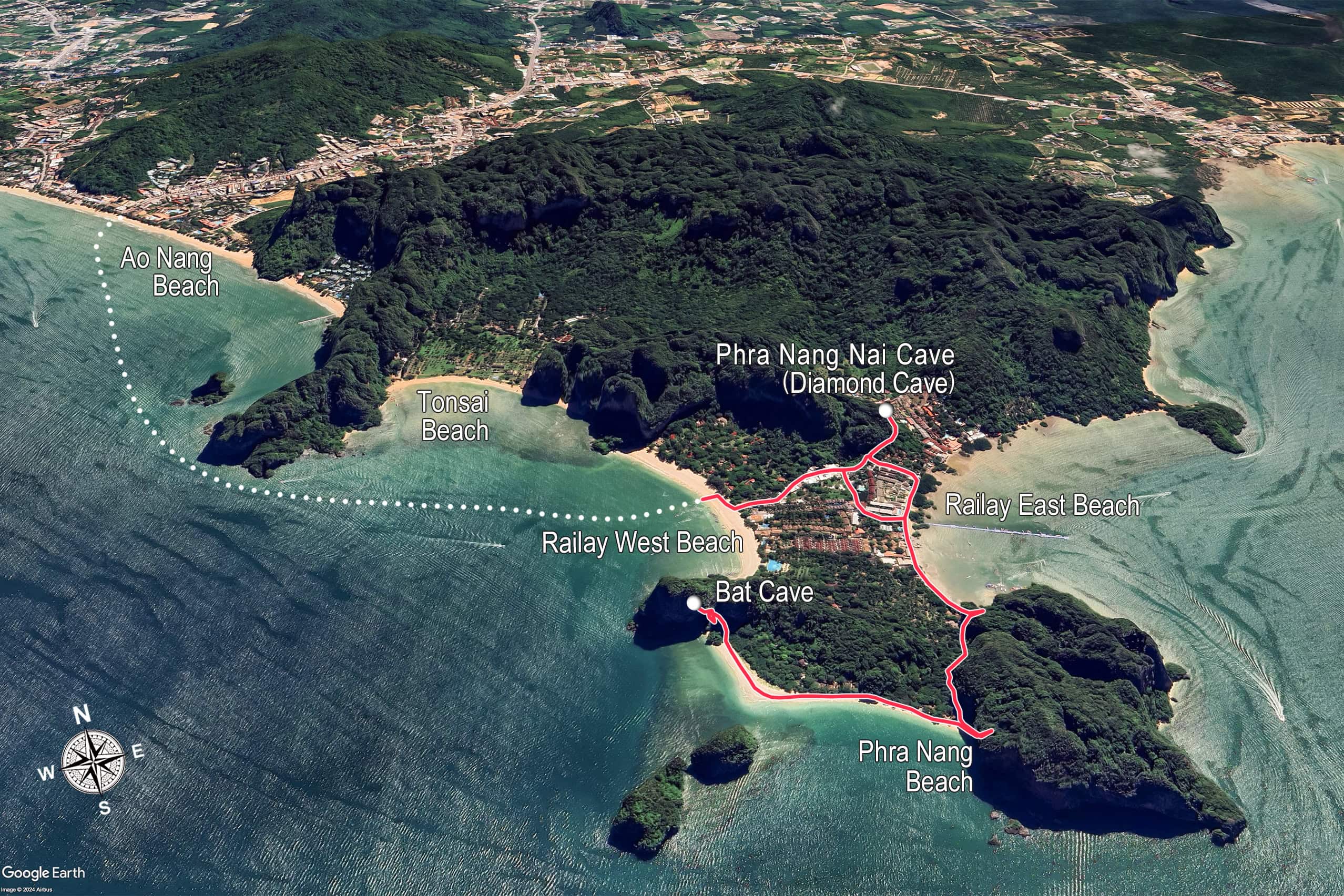
From Ao Nang to Railay
At the end of our stay at Krabi’s Ao Nang Beach in Thailand, we took a long-tail boat to visit the famous Railay Beach.
Railay Beach lies at the narrow neck of Railay Bay. The small peninsula is cut off from the rest of Krabi by towering limestone cliffs, with no road access. The only way in is by sea, and long-tail boats and speedboats shuttle visitors from nearby beaches throughout the day.

From Ao Nang, Railay West — one of two main beaches at Railay, the other being Railay East — is just a 15-minute boat ride. A round-trip long-tail ticket costs 200 THB per person.
We left our hotel early, right after breakfast, to stay ahead of the big wave of day-trippers heading from Ao Nang to Railay.


Although we weren’t sure which boat was ours, a Thai boatman approached us as soon as we walked down to the beach and took one of our tickets. After glancing along the row of boats, he pointed us toward one that already had a few passengers on board. We were lucky — the boat was just about to leave. If we had missed it, we would have had to wait until enough people arrived to fill the next boat.



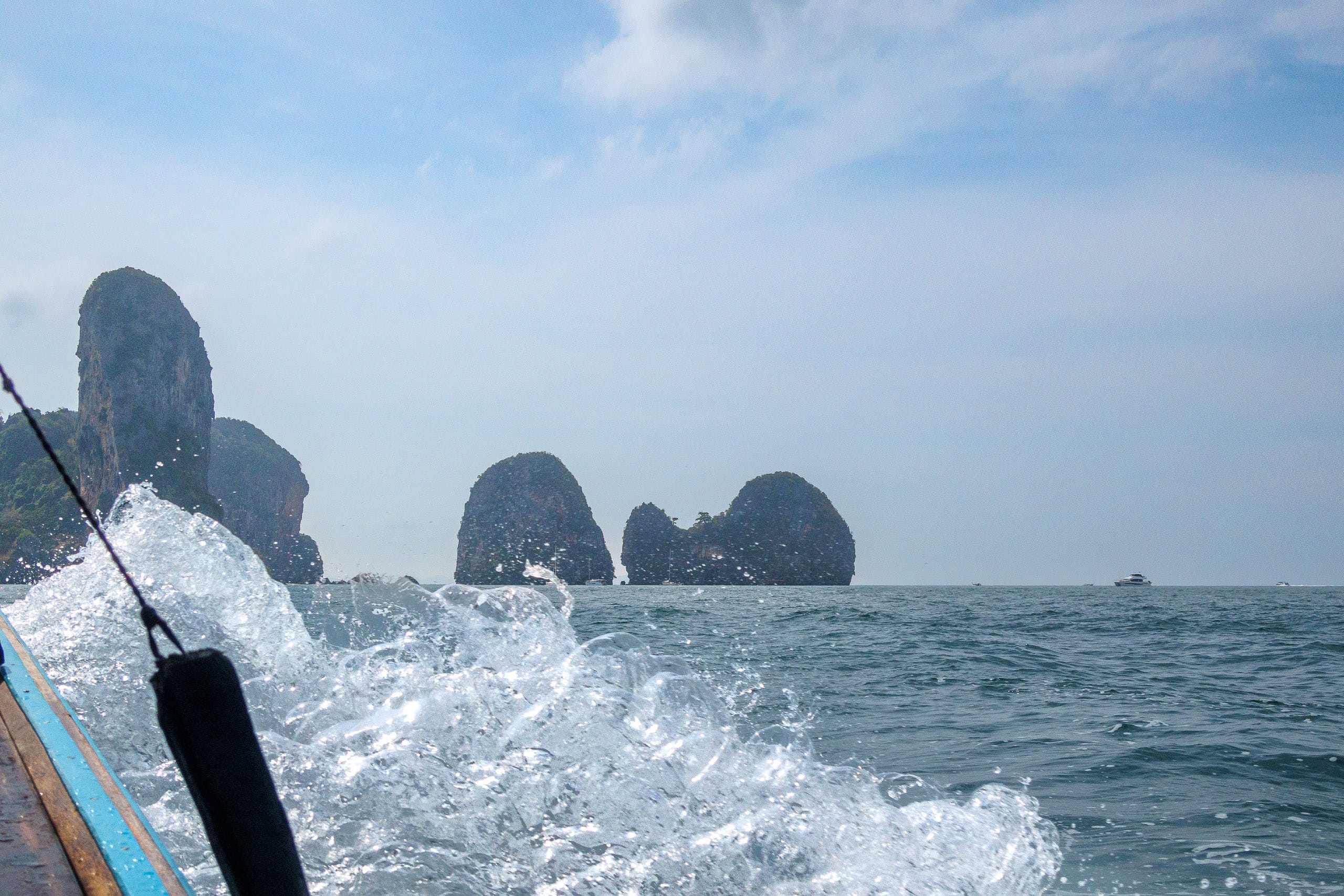
From Railay West to Phra Nang
We arrived at Railay West Beach at 9:45 a.m. It was still quiet, with most shops and cafés just preparing to open.
We hadn’t brought any water or food, assuming we could buy some in Railay. But we were a bit too early. After failing to find anything open on the main street, where bars and restaurants lined both sides, we finally came across a small shop on Railay East Beach and bought a rather expensive bottle of water. In the end, we didn’t really need it this time, but you never know how hot it might get or how far away the next source of water will be.

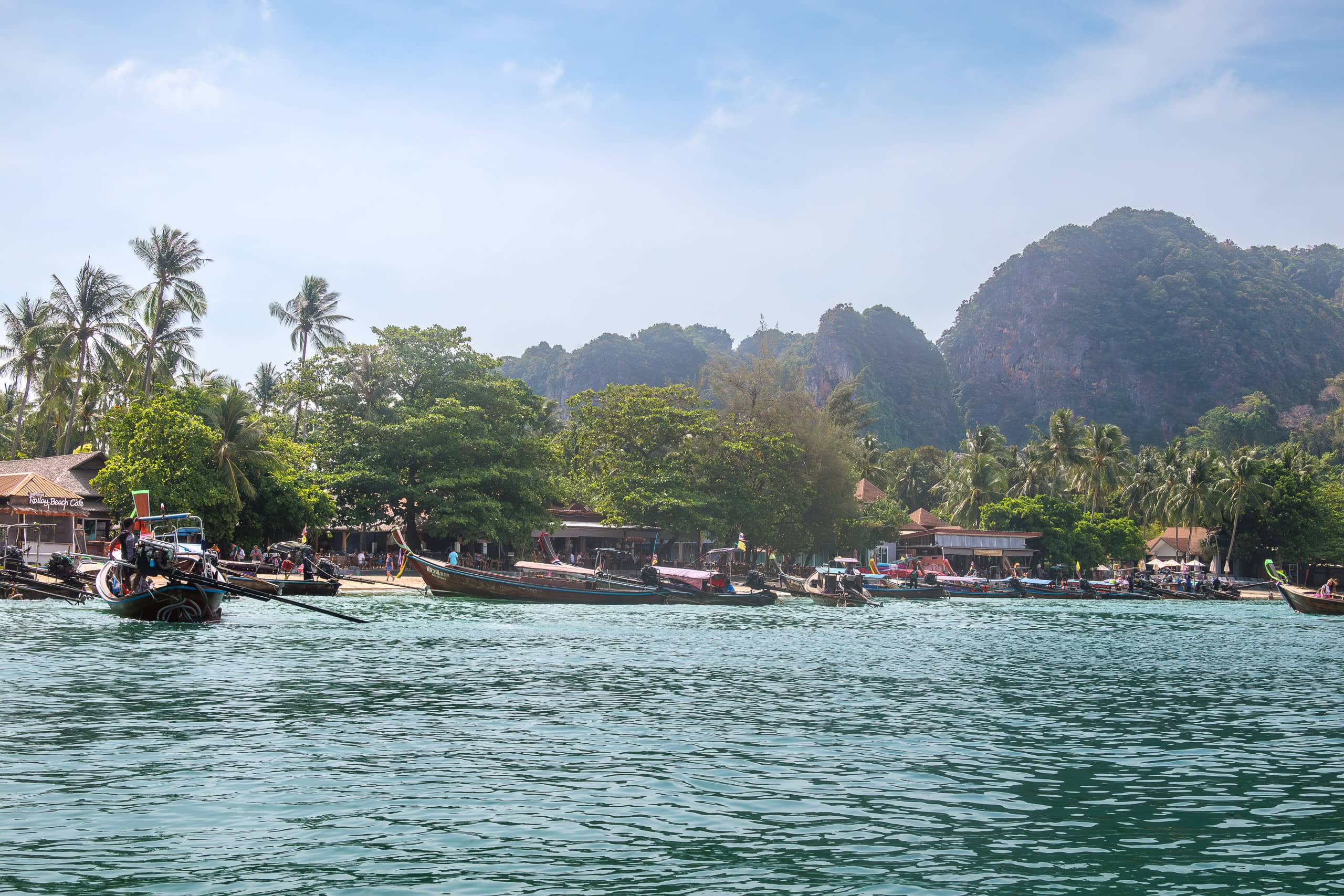
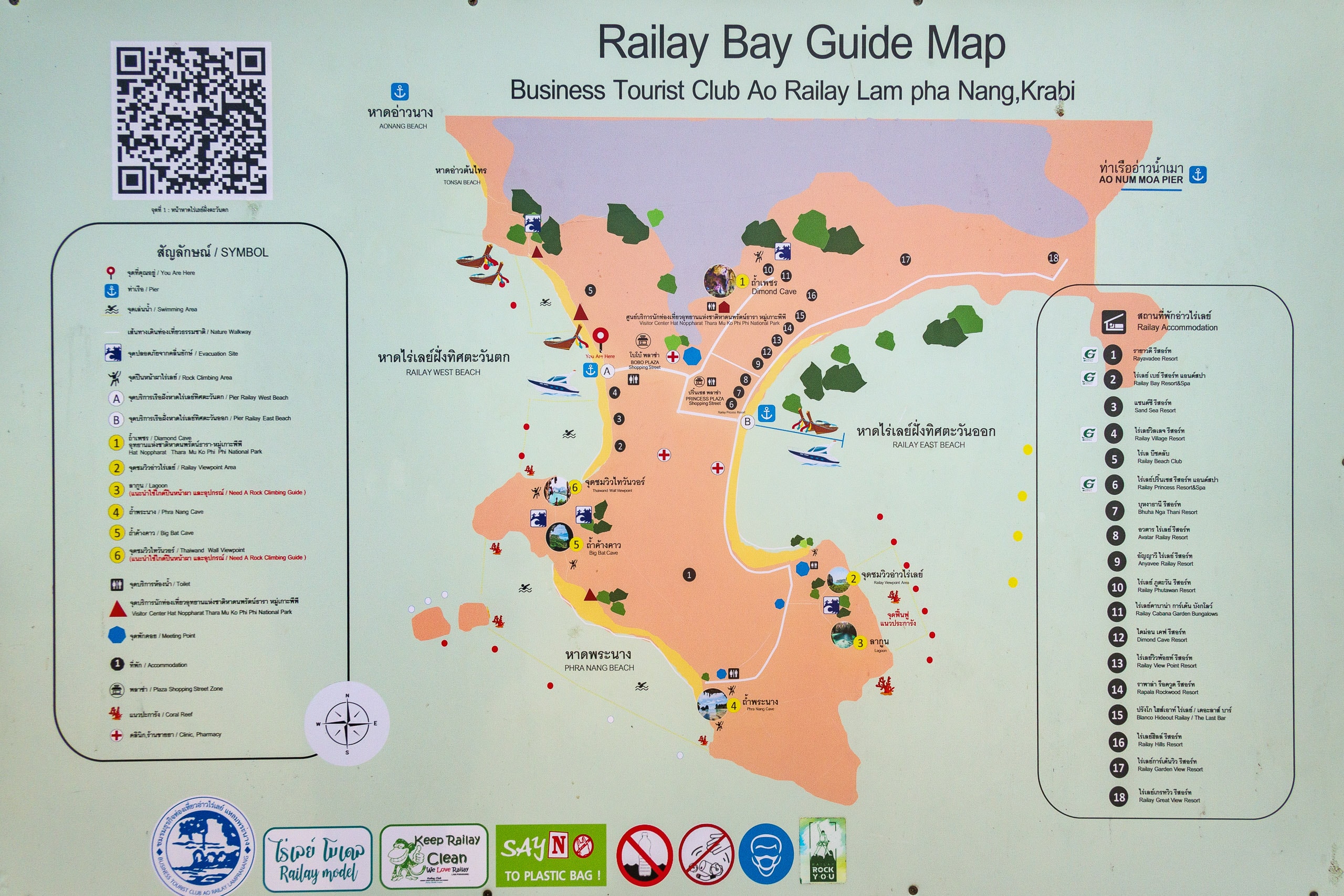
As expected, most visitors came to Railay to swim in the calm, stunningly clear turquoise-green water and to relax on the powder-fine sand. Rock climbing on the limestone cliffs was also very popular. We passed several climbing shops along the main street, so climbers of all levels could come without bringing their own gear. Surprisingly, many people were already climbing the sheer cliffs, with local guides assisting and giving instructions.


Climbing, however, wasn’t our reason for coming. We were here to see a couple of caves.
Our first destination was the Bat Cave. It lies inside the massive limestone cliff at the edge of Railay West Beach, but without proper climbing skills and gear, ordinary visitors can’t reach it from that side. To access the cave, we had to walk all the way around to Phra Nang Beach on the far side of the cliff.
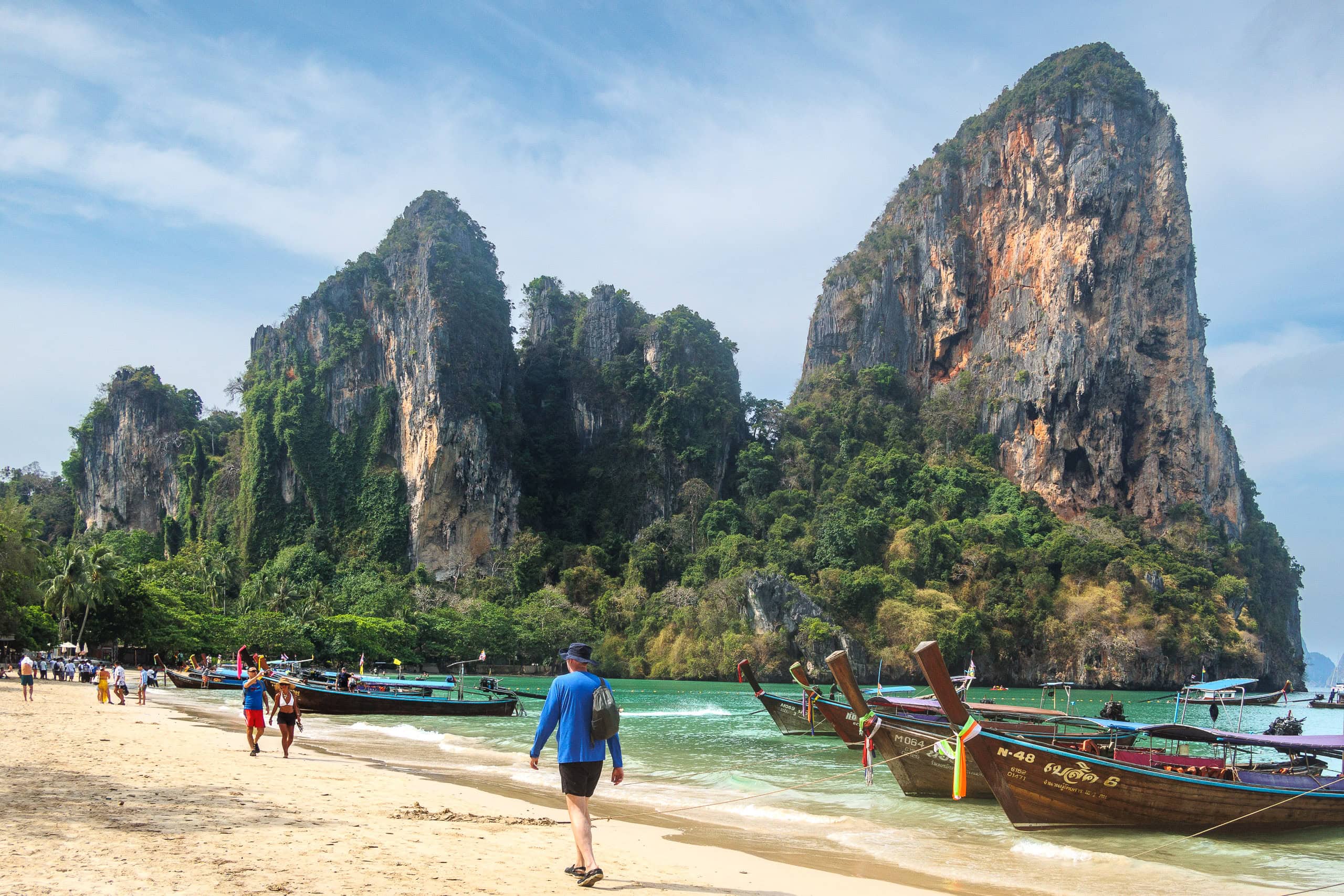
Phra Nang Beach is the most popular beach in Railay. Since it is entirely a swimming beach, no boats are allowed to approach, which is why, as mentioned before, the long-tail boats from Ao Nang generally only shuttle to Railay West Beach.

After walking through the still quiet early morning main street, we came out to the East Beach.
This side has a floating boat dock for visitors from downtown Krabi. Most of Railay’s hotels are located here, and the shoreline is almost completely shielded from waves by dense mangrove trees standing in the shallows.

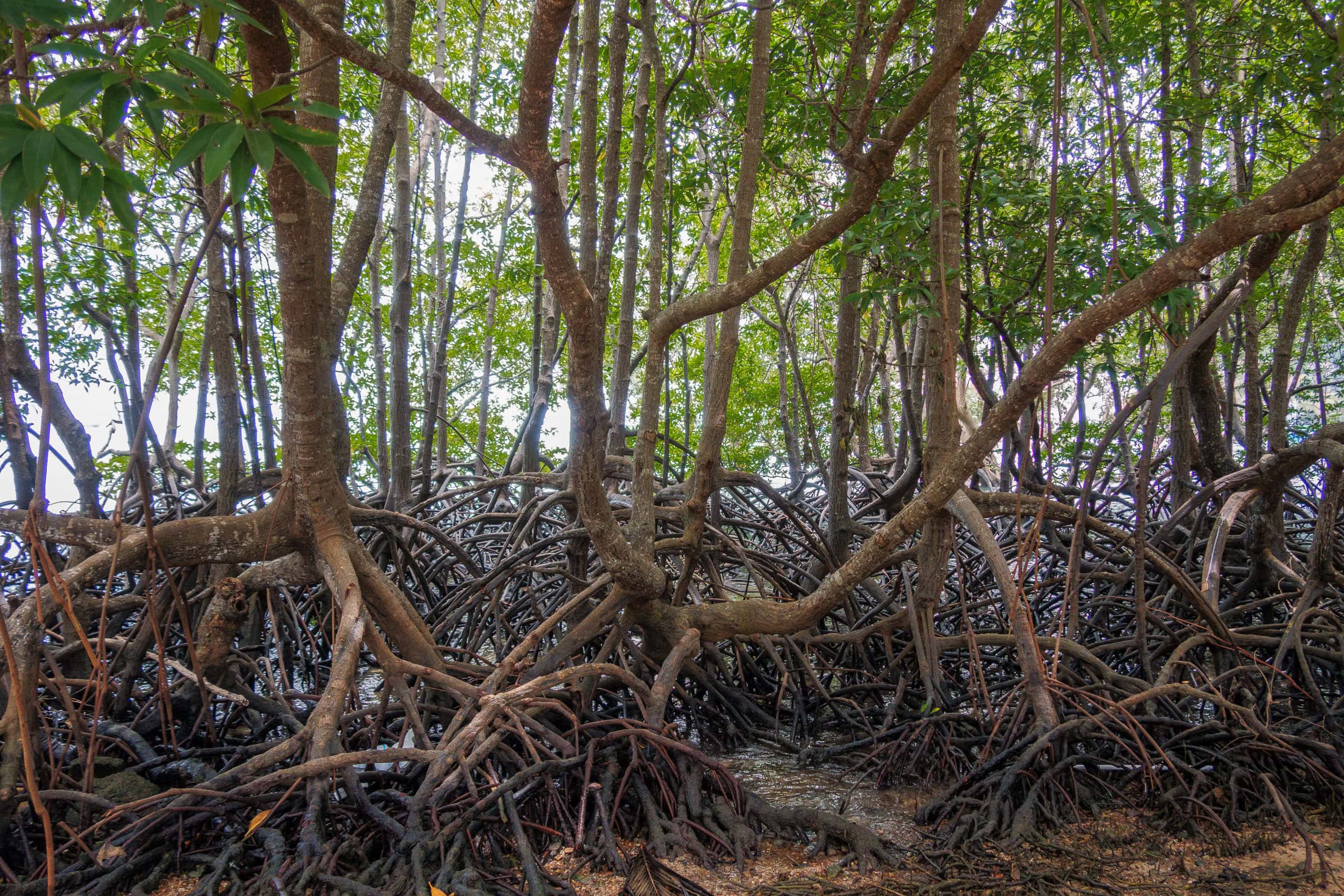
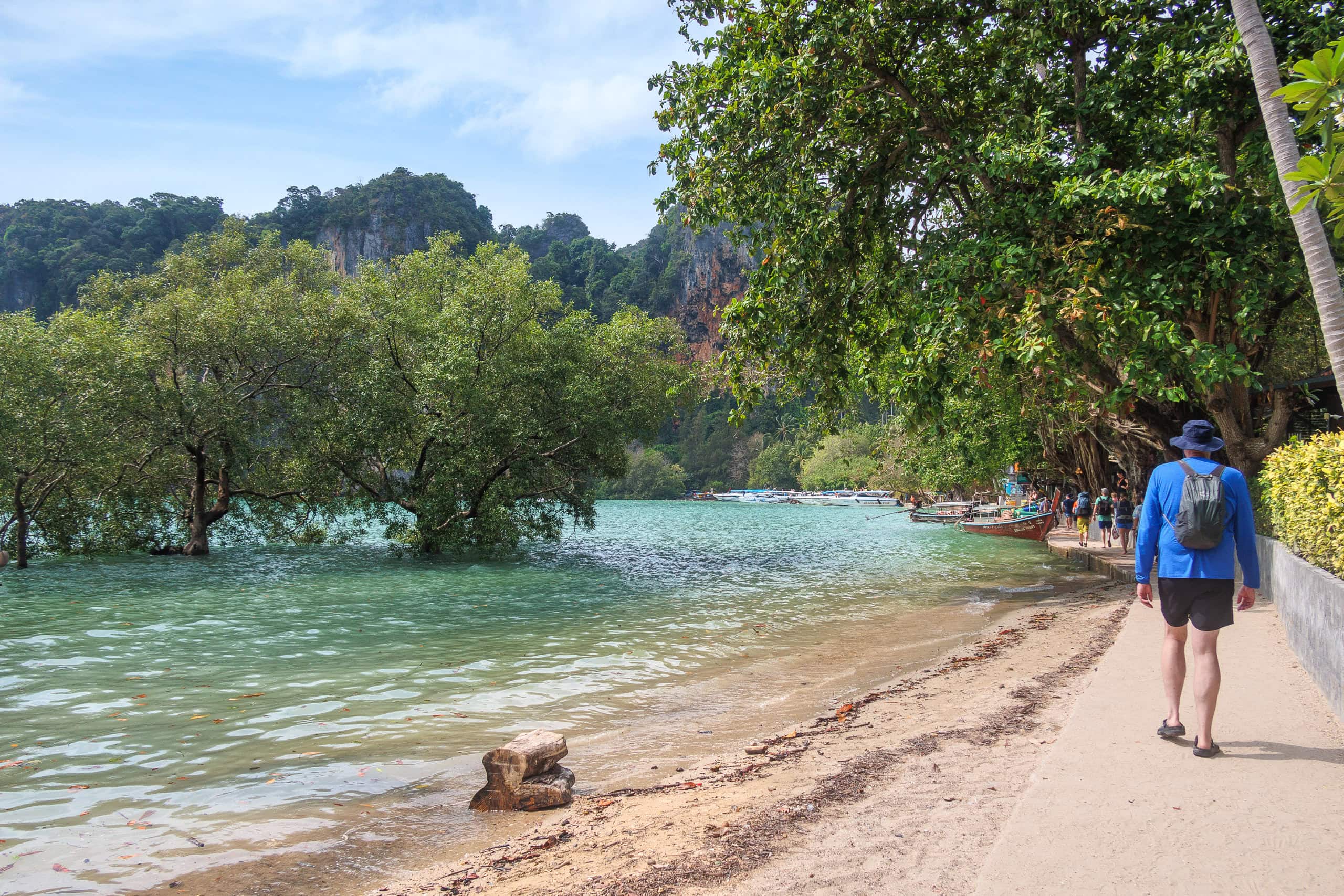

From there, we simply followed the stream of people along a wave-washed, narrow path. The tip of the Railay peninsula is a towering limestone mountain.


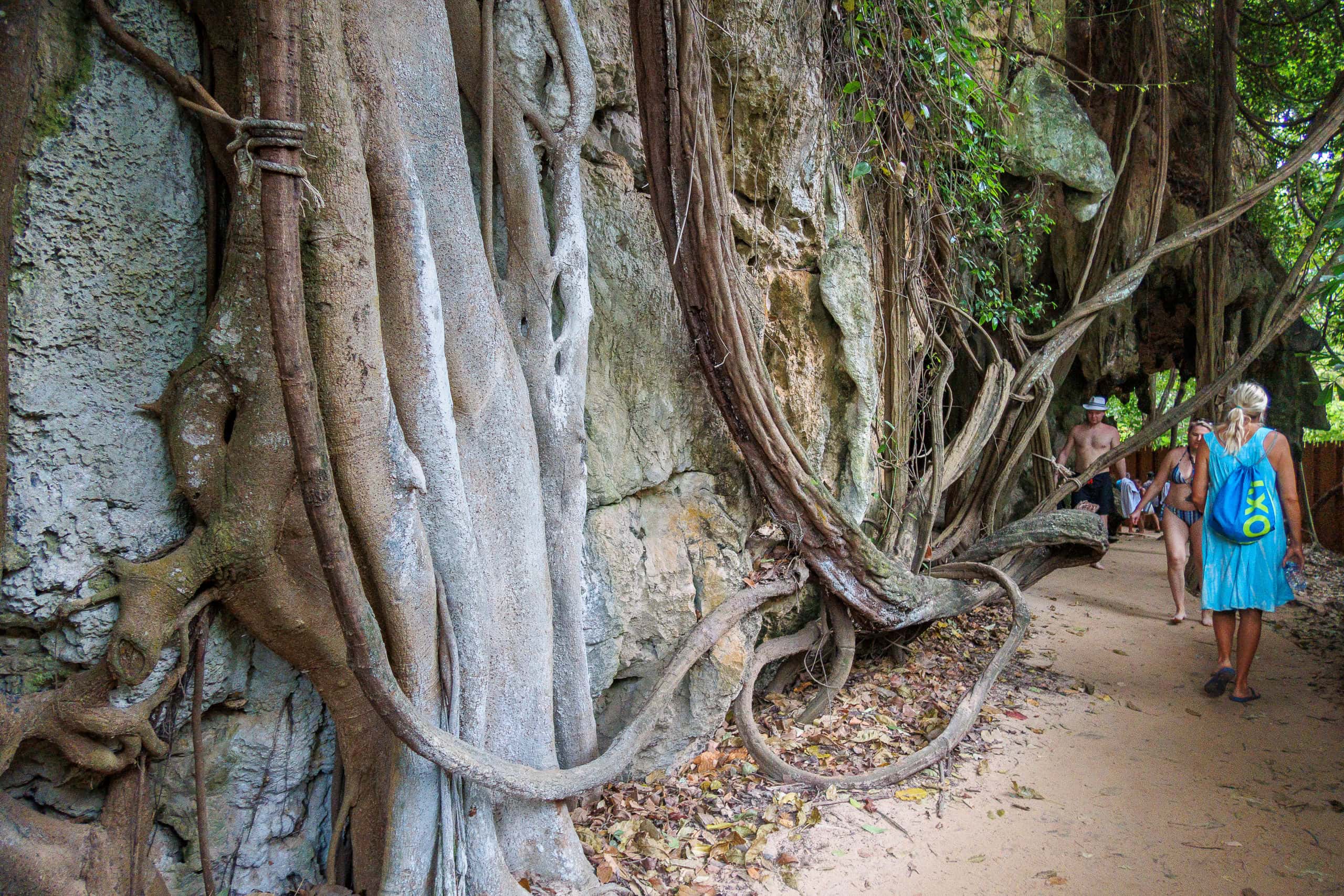
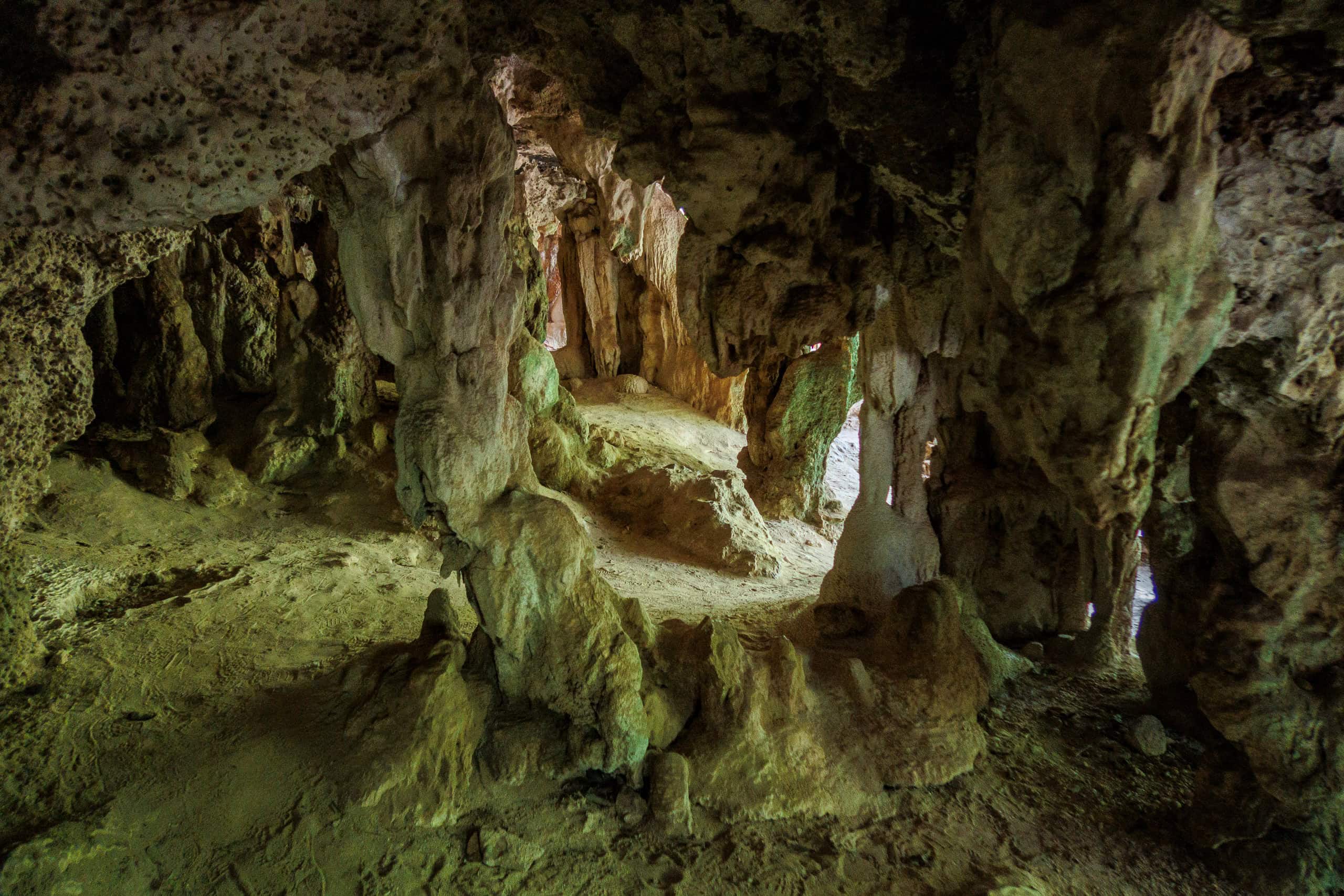

Walking along the base of the cliffs, under hanging stalactites of all shapes, we headed toward Phra Nang Beach. Along the way, we saw a few people carefully making their way down a steep side trail that connected to our path. Apparently, it leads to a hidden lagoon in the middle of the mountain — a beautiful blue lagoon, at least when it has water. But in late March, during Thailand’s dry season, recent reviews said the lagoon had already dried up. So we decided to skip the detour.
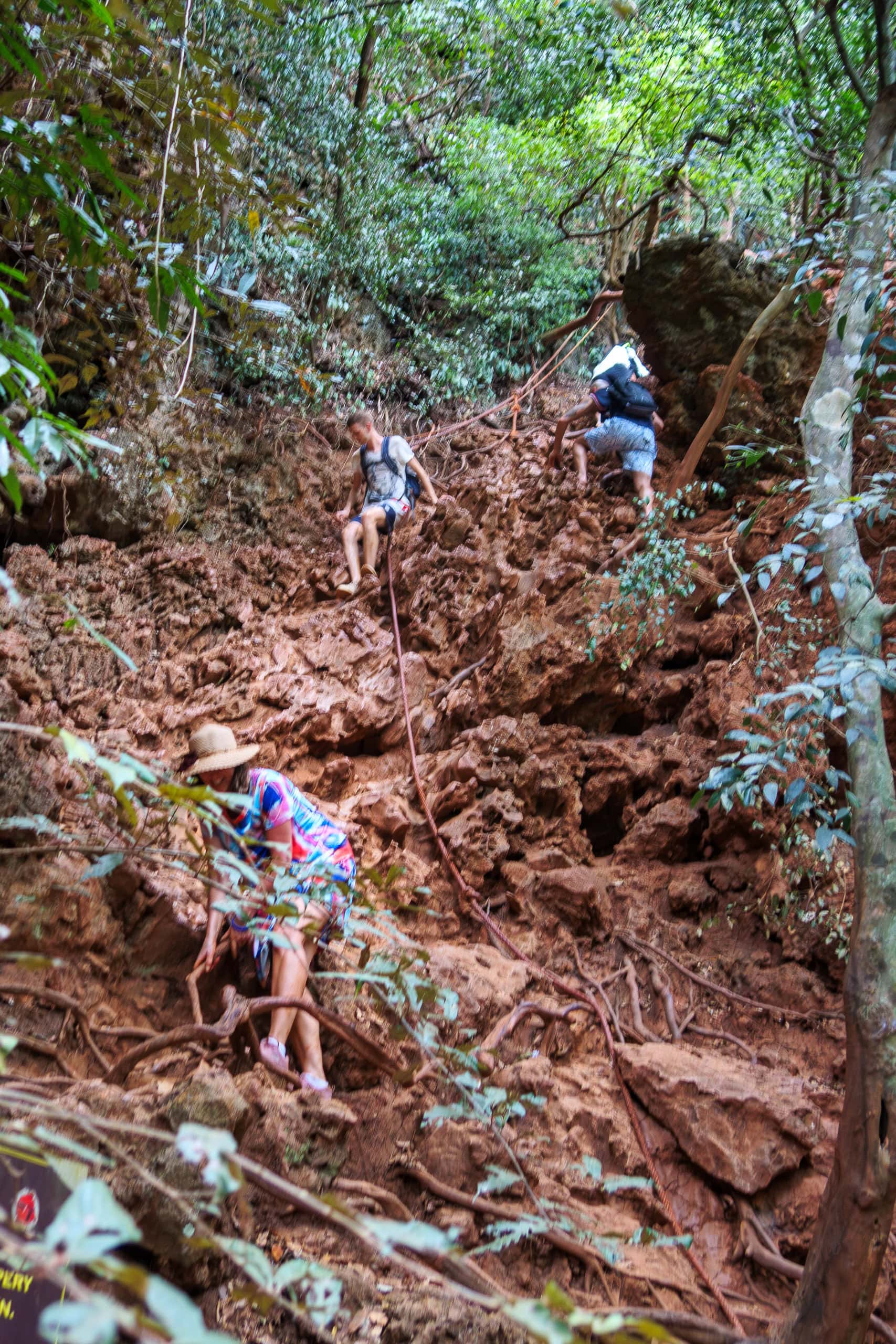

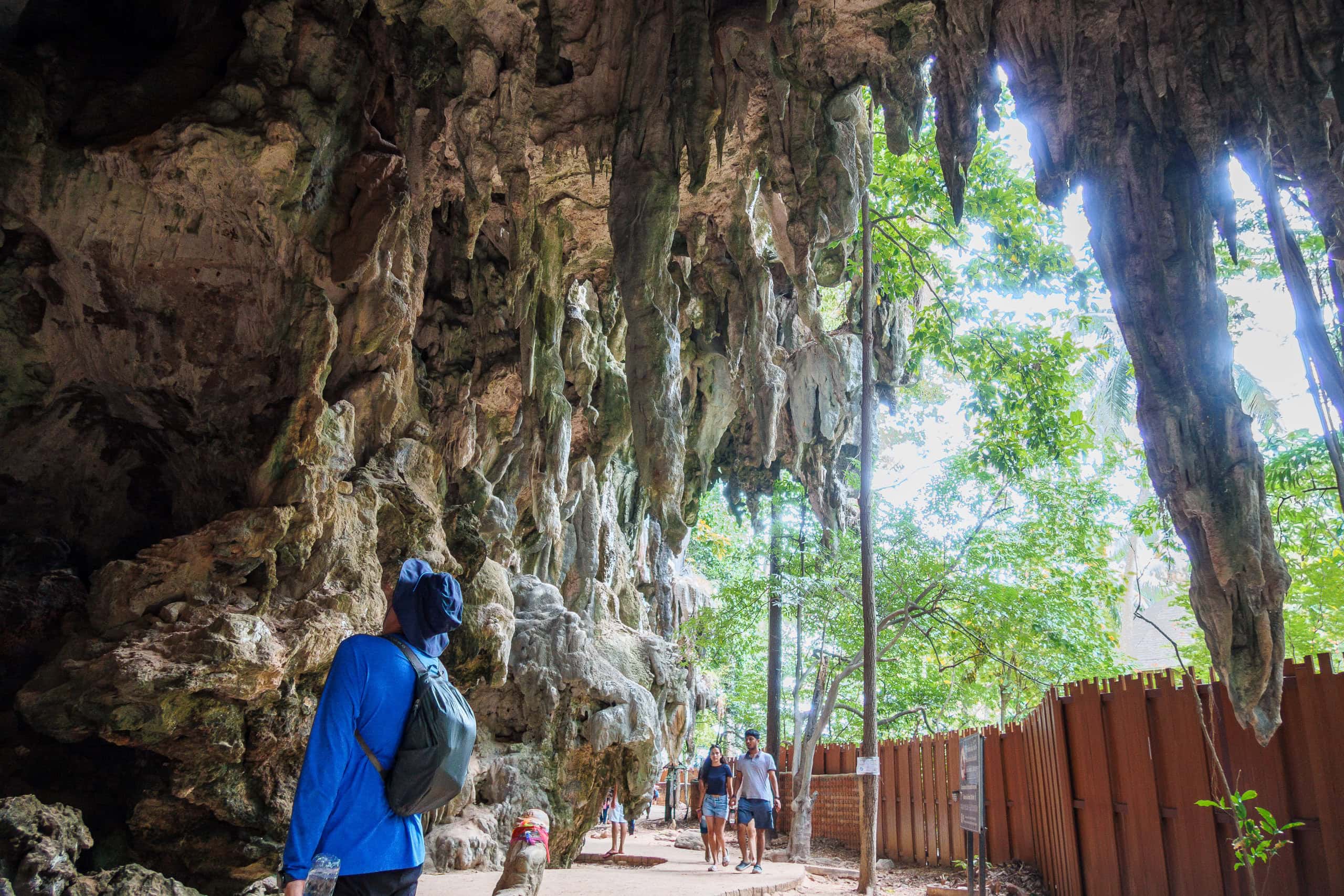


The Phra Nang Beach
Phra Nang Beach was clearly popular — surprisingly, many people were already there that morning. A large group of climbers had gathered at a cliff wall, watching a few fellow climbers attempt to go higher. Along the shore, crowds of tourists posed happily for photos of the turquoise water and dramatic rock islands.
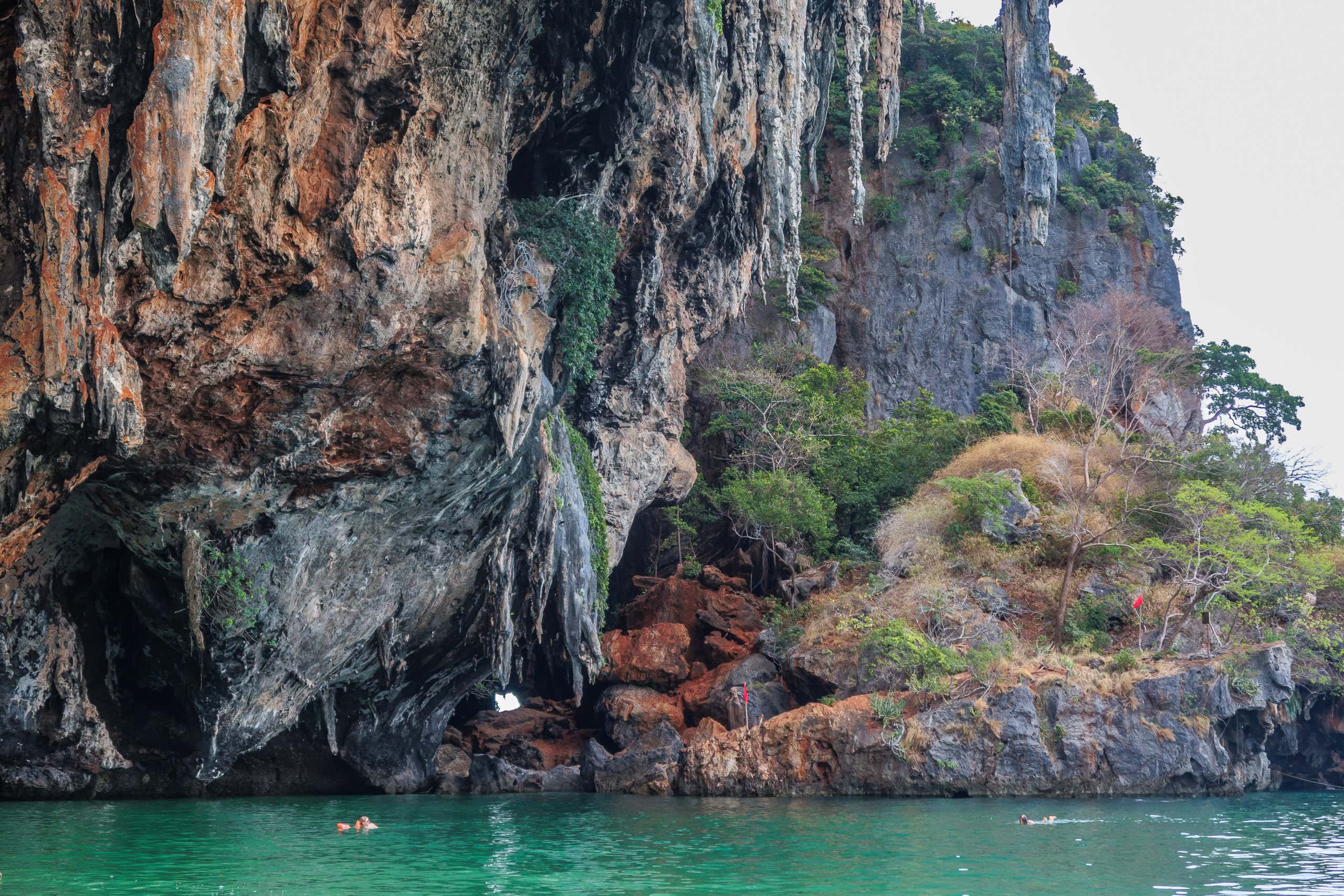


At one end of the beach were two small caves. Despite being so close to the crowds, both caves were quiet. Curious visitors lingered nearby, giggling but hesitant to step closer — for obvious reasons.
Inside the caves were piles of long, colorful wooden sticks shaped like phalluses. Most were simple and modest in design, but some were graphic and detailed. People seemed to glance sideways at each other, waiting to see who would be “the brave one” to go in.

Coming from Japan, this wasn’t the first time we had seen such a place. Anyone who has watched YouTube videos about Japan’s “weirdest” shrines, museums, or festivals has probably encountered something similar.
As we observed, a few serious-looking local couples were praying together for a long time. We guessed the caves were connected to fertility — and a quick Google search proved us right.

We started walking along the shore to the opposite end of the beach, where the Bat Cave cliff stands. Soon, the high-tide seawater completely covered some parts of the sand beach, and we could not keep our feet dry anymore. Thankfully, the water level was not too high, around my knee height, so people could easily walk in the water to cross the below-water parts. The beach should be entirely exposed and dry during the low tide.

When we got on and off the long-tail boat, we wore water sandals to walk a bit in the water. But we had already changed to our regular Altra trail runners and felt too lazy to take them off and put on the sandals again. So, we kept walking in the water with Altra’s shoes on.
Although Altra’s trail runners are good at pushing the water out of shoes and getting dry quickly, this was not the best decision. The sands of Phra Nang Beach were too fine, like powdered sugar, and so hard to completely get rid of from inside shoes even after we thoroughly washed and dried them later. For the next few days, the sand still came off when we turned our shoes upside down and patted them.

After passing the water-covered parts, the beach became much quieter. Reaching the near end of the beach, we found a part of the tall shrub thickets behind the beach was cut and made a small tunnel to the cliff. A very short walk took us to a steep slope trail. With the help of a thick support rope and small rocks on the slope, we clambered up quickly to the top of the slope and found a narrow but easy-to-walk path stretched further through the big rocks to a dark crevice in the rock cliff.
Passing a few rock climbers practicing their skills and some hand-made wooden ladders, we arrived at the mouth of the Bat Cave.


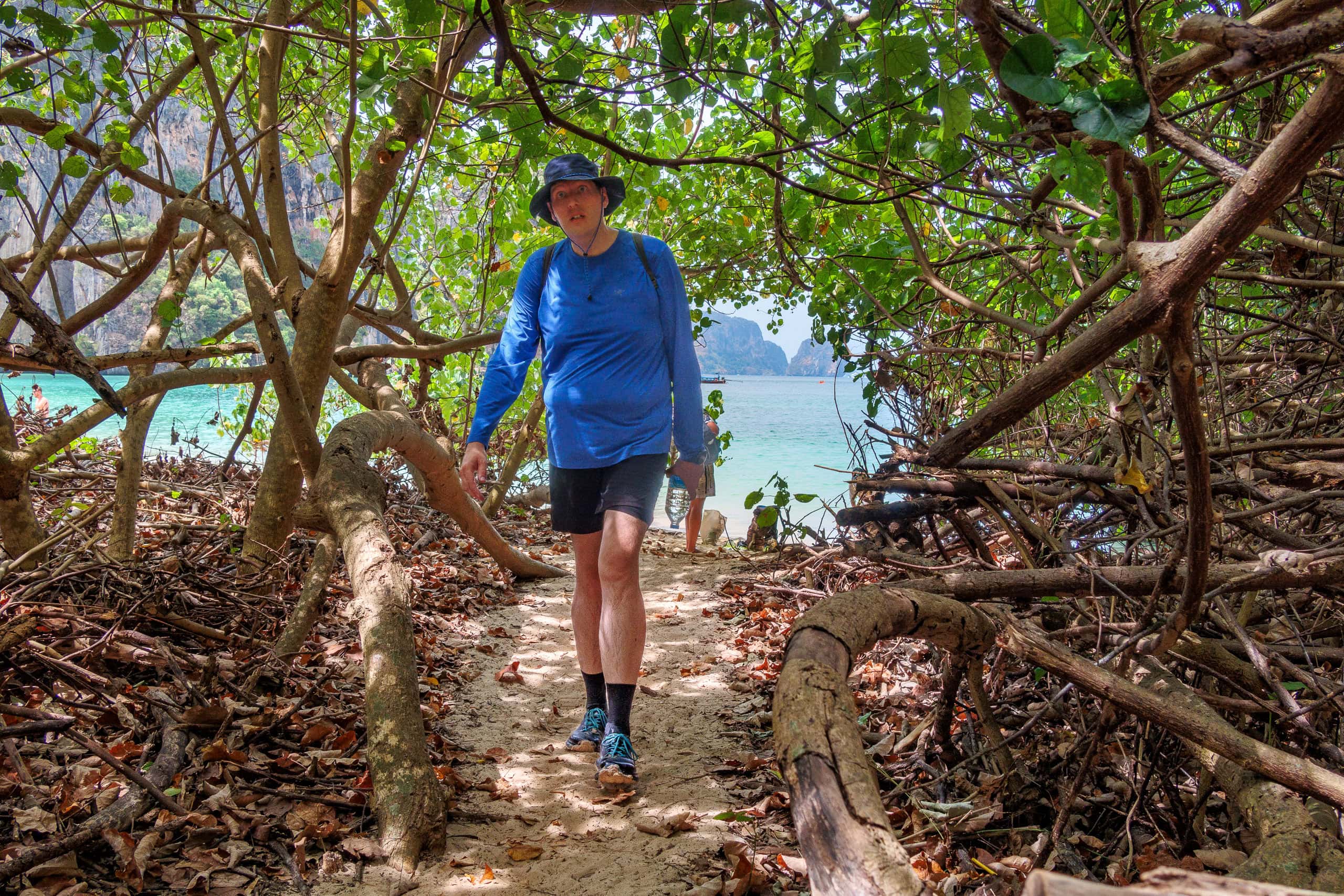




The Bat Cave
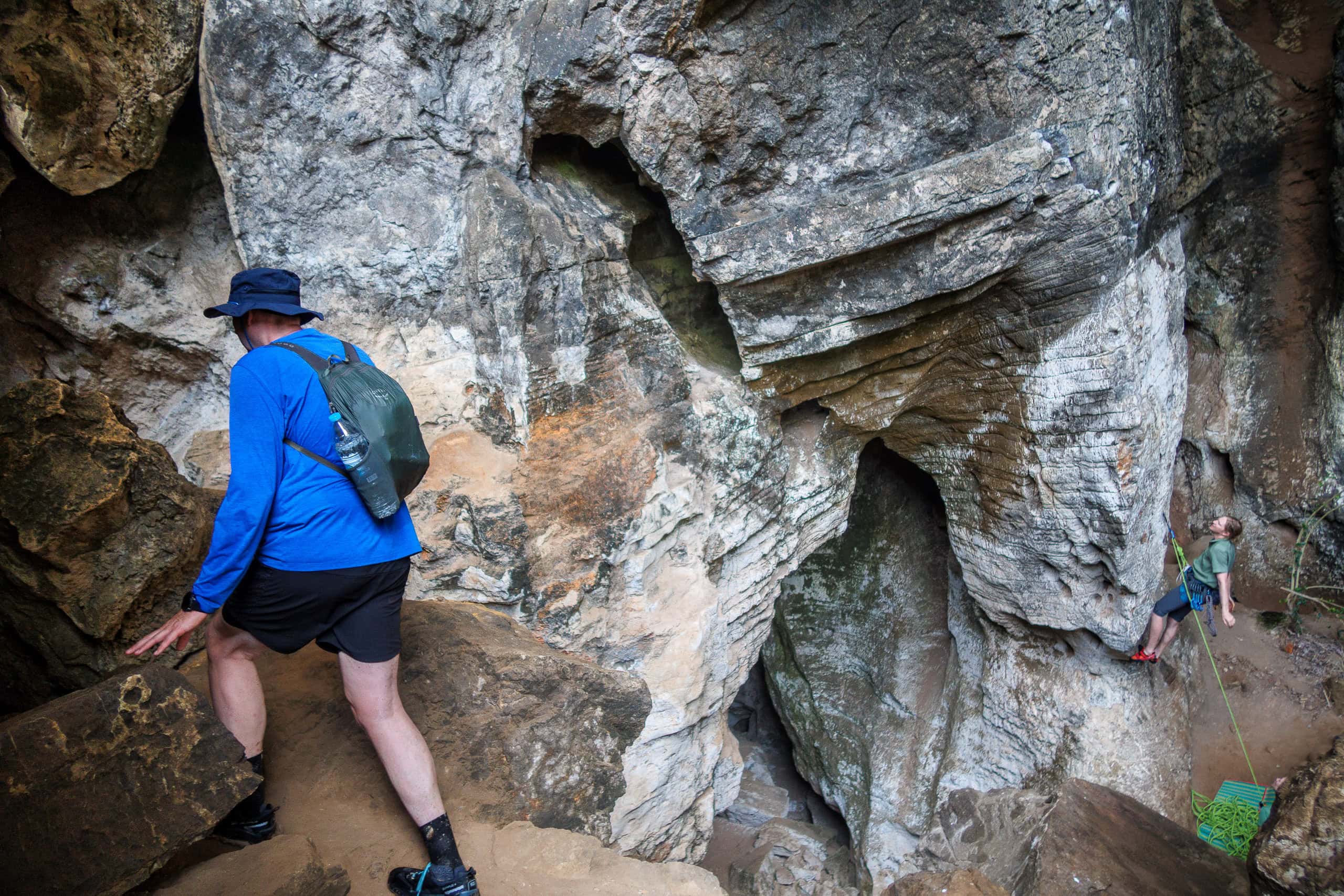
Passing a few rock climbers practicing their skills and some hand-made wooden ladders, we arrived at the mouth of the Bat Cave.
Inside the cave was a big hall, and its front parts were exposed to sunlight coming through many cracks and holes. Because of that, most stalactites were pretty weathered and lost their delicate forms. The surface under our feet had been smoothed out over time by wind, running water, and probably many people walking on it.



The cave was fun to walk around. We explored further into a deeper area of the cave and found a dark, small hole with a knotted guiding rope attached. After making sure no dangerous animals hid in there with the flashlight of our phone, we slid into the hole.
It was a smaller room, but the ceiling was higher than Erik stood up straight. Our phone flashlights spotted a small colony of bats hanging upside down with bated breath. Or maybe they were just relaxing as they didn’t move or fly at all, even in the spotlight. I appreciated them for letting me take a good photo of them.


According to the hiking logs of the past visitors, there should have been a path through the cave to reach the Railay West Beach side’s cliff wall. In the corner of the dark bat colony room, we found a bamboo ladder leaning onto another dark hole.
Suddenly, a young Western guy only in his speedo and hiking sandals, wearing a headlight, came in from behind us, went straight to the bamboo ladder and disappeared into the dark as if it was just an everyday routine. While we were taking photos of the bats, he reappeared from the same hole again and quickly left the bat room.
Puzzled with what just happened in a very short time, we tried to sense beyond the dark hole, holding our breath. We did hear multiple human voices from somewhere distance, but we are not sure about whether they came from the hole or somewhere else.
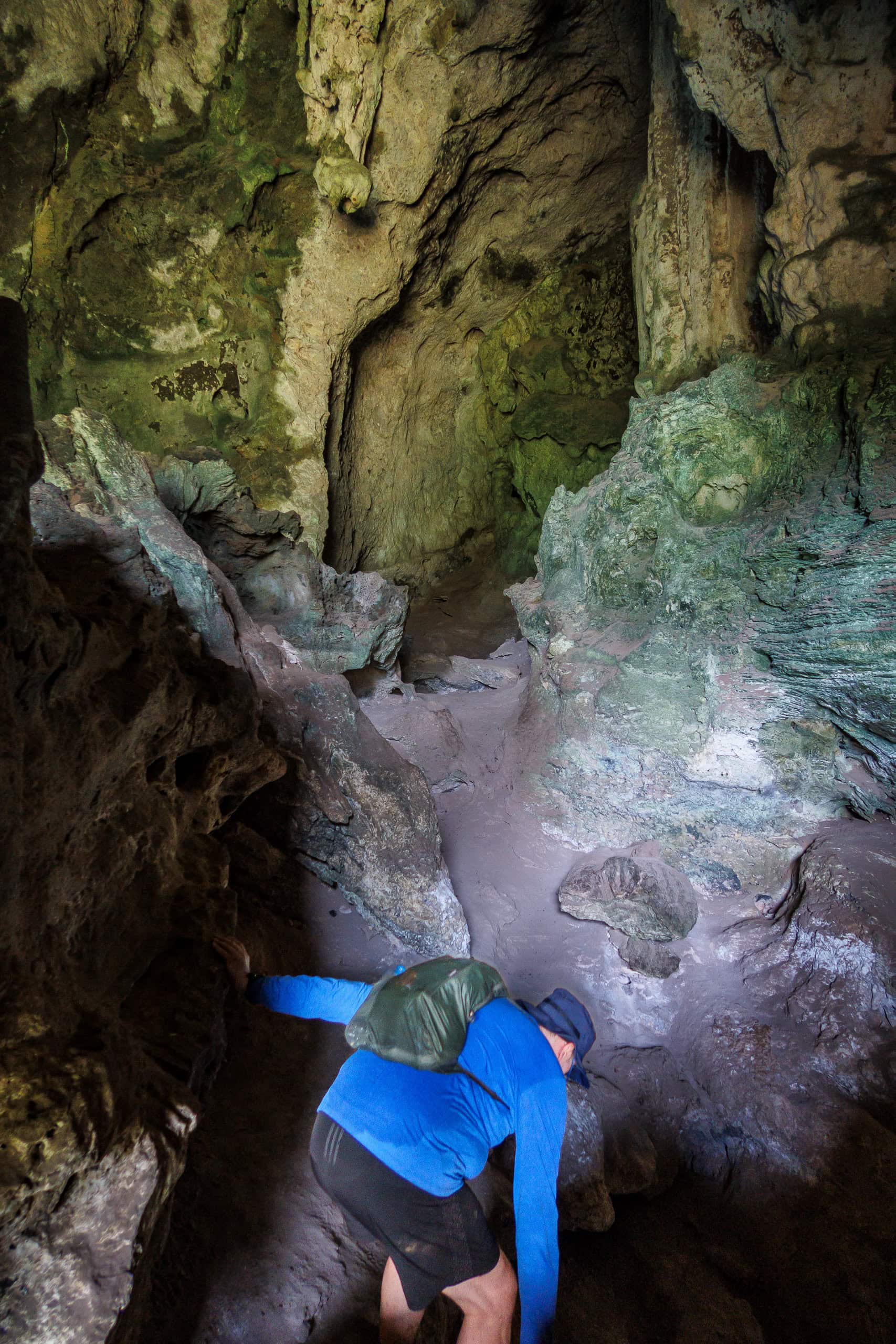

Our original plan was to reach the Railay West Beach side’s end of the Bat Cave and then walk down to the beach, if possible. From Railay West Beach, we wanted to go further to Tonsai Beach, from which a nature path should run through forests behind two beaches in the direction of the Diamond Cave near Railay East Beach. Although we had the GPS track of the route and headlights, we had no idea if this route was an easily walkable condition for casual hikers like us. It was highly possible that the person who provided this route log on the internet was a climber.
After all, we decided not to give it a go.
We would check out the next morning, so we had to go back to our hotel in one piece and pack up.
We turned around and went back to the bright side of the cave.
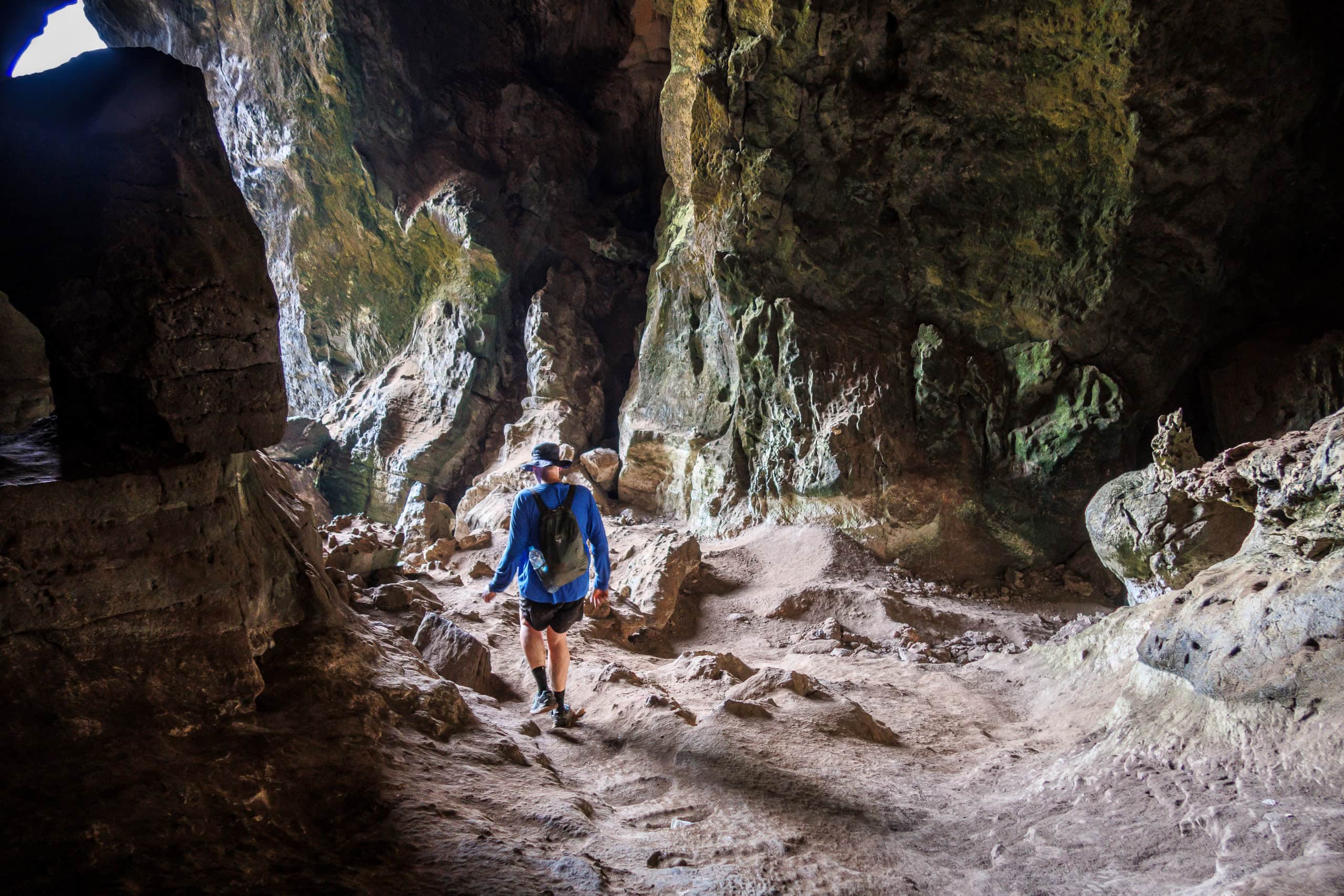

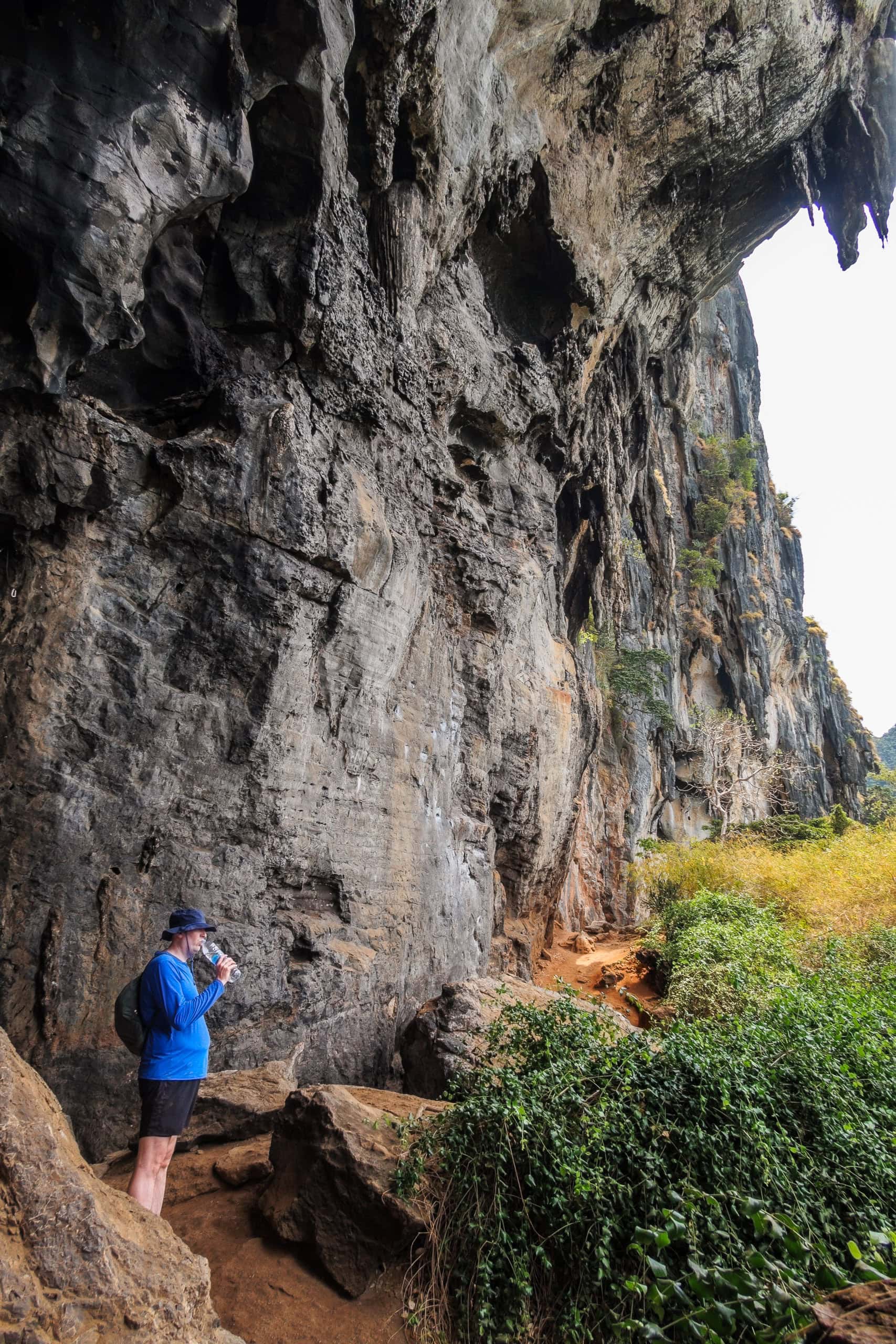
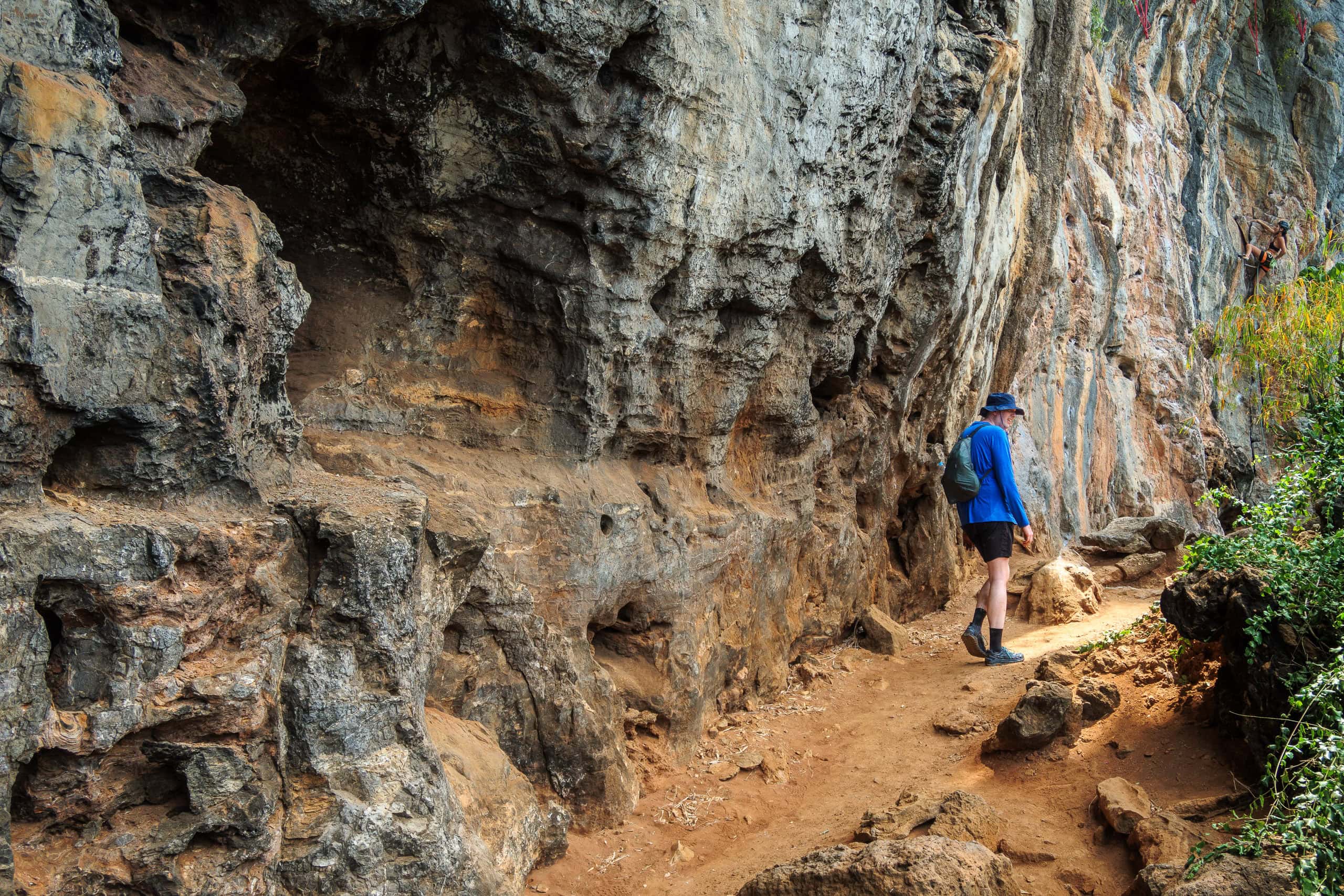

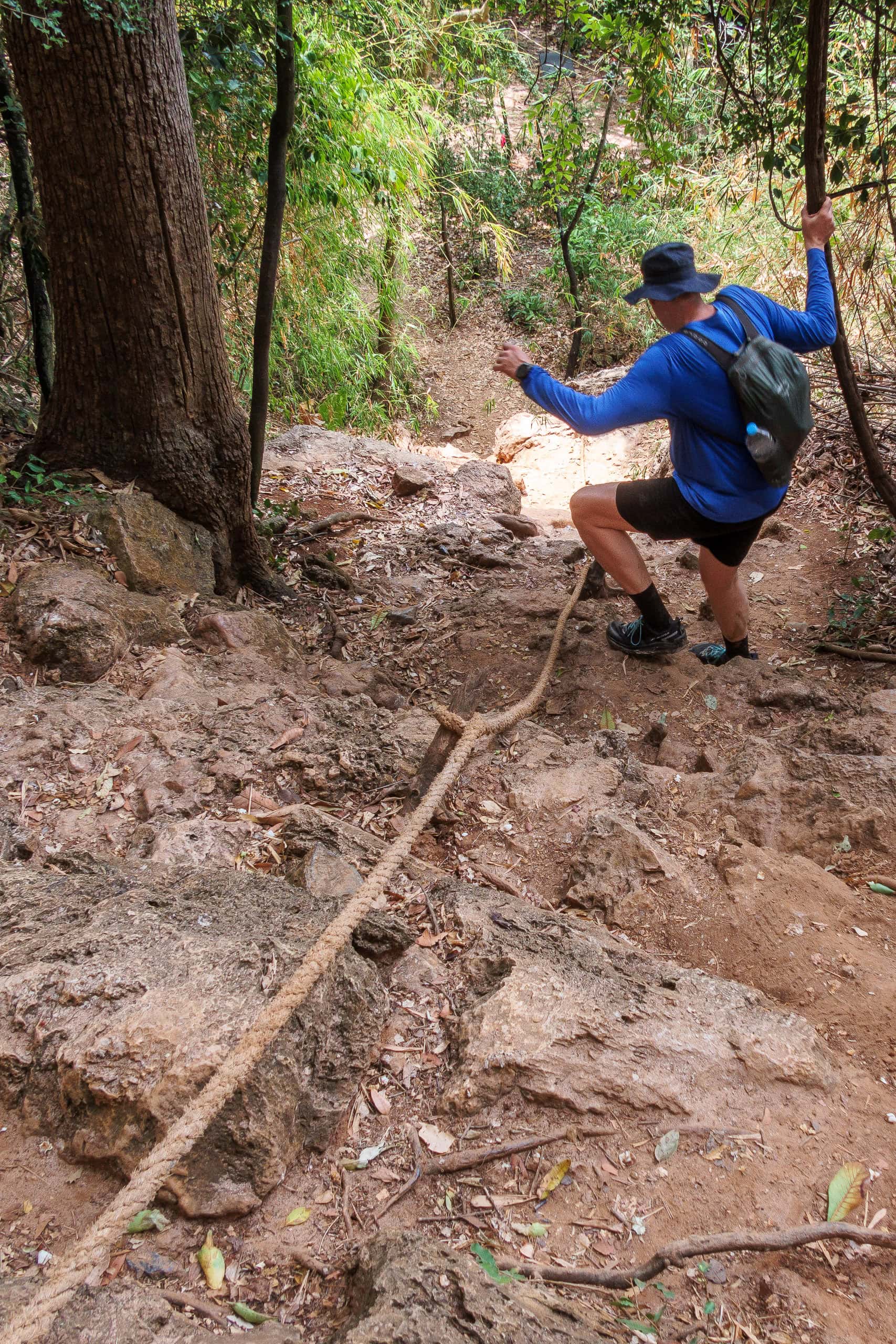
We simply traced back to the way we came, crossing the water, which was now lower than before, passing a monkey family posing for tourists’ photo shoots, and came back to the Railay East Beach area.





The Diamond Cave (Tham Phra Nang Nai)
After getting refreshed with long-awaited icy cold drinks at a hotel terrace cafe, we followed signs to the Diamond Cave.

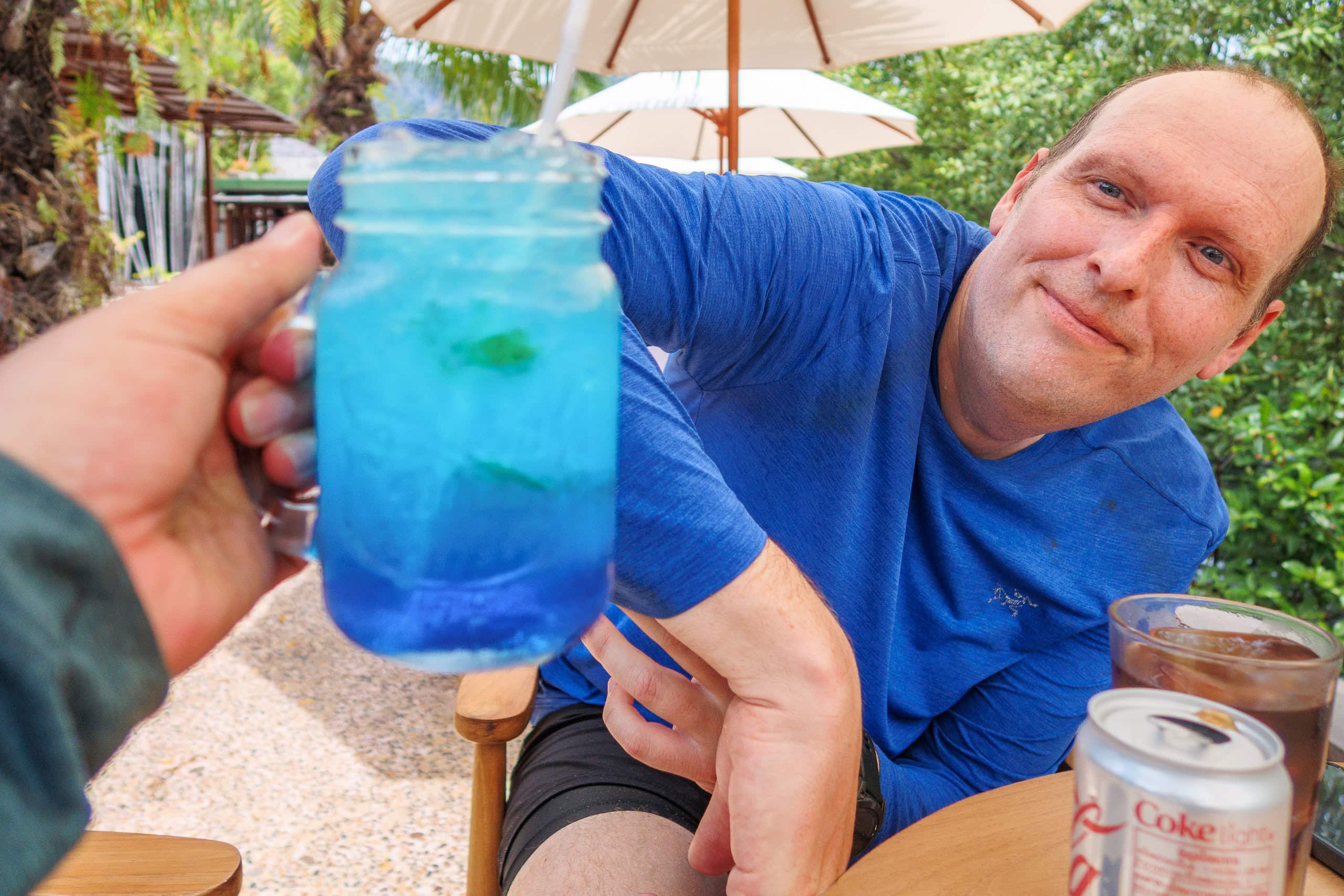


Unlike the Bat Cave, the Diamond Cave (Phara Nang Nai Cave) was a show cave with well-maintained passageways and colorfully illuminated beautiful stalactites, stalagmites, and other cave formations. We paid the entrance fee in front of the cave mouth: 200 BTH per person as of spring 2022.
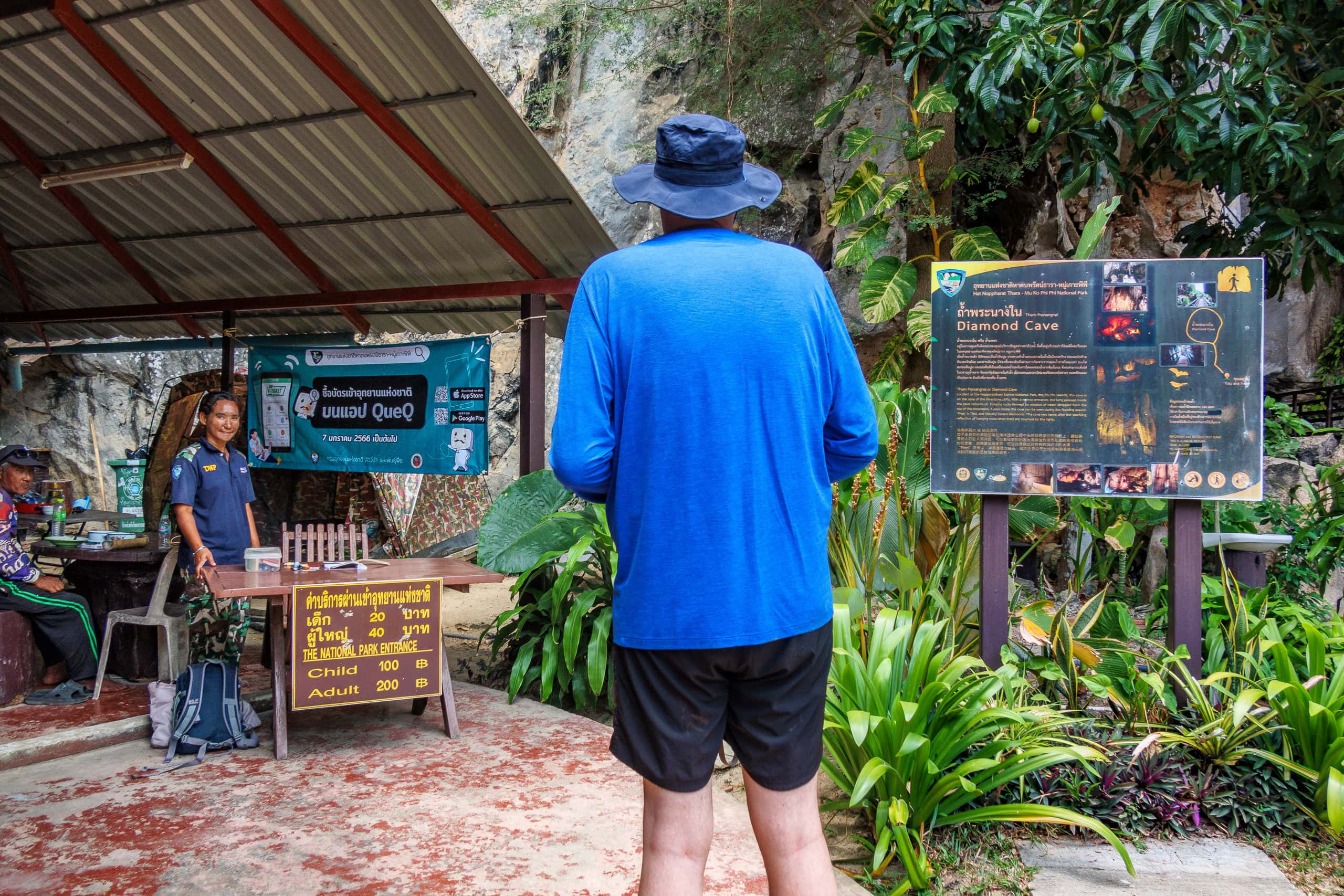

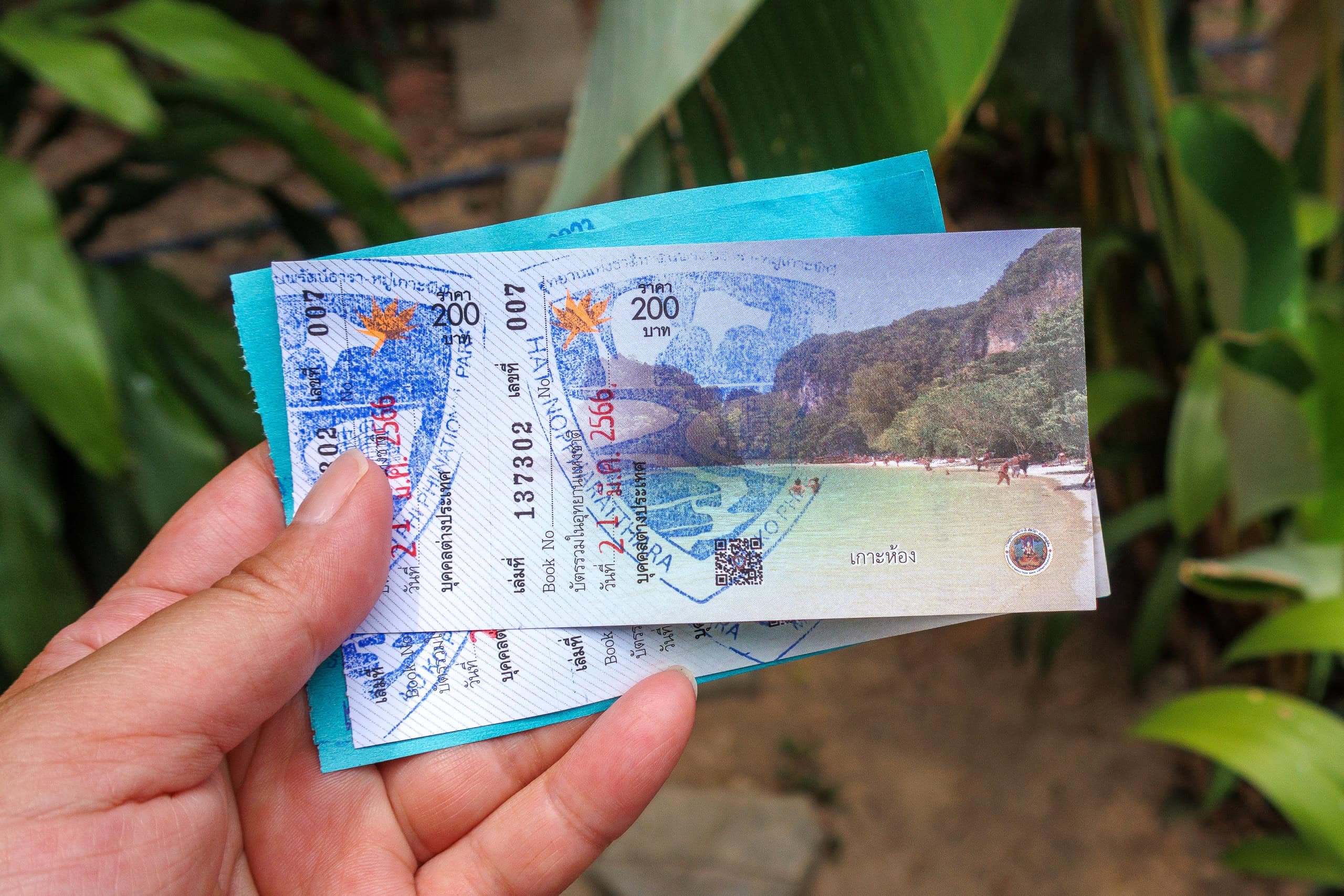
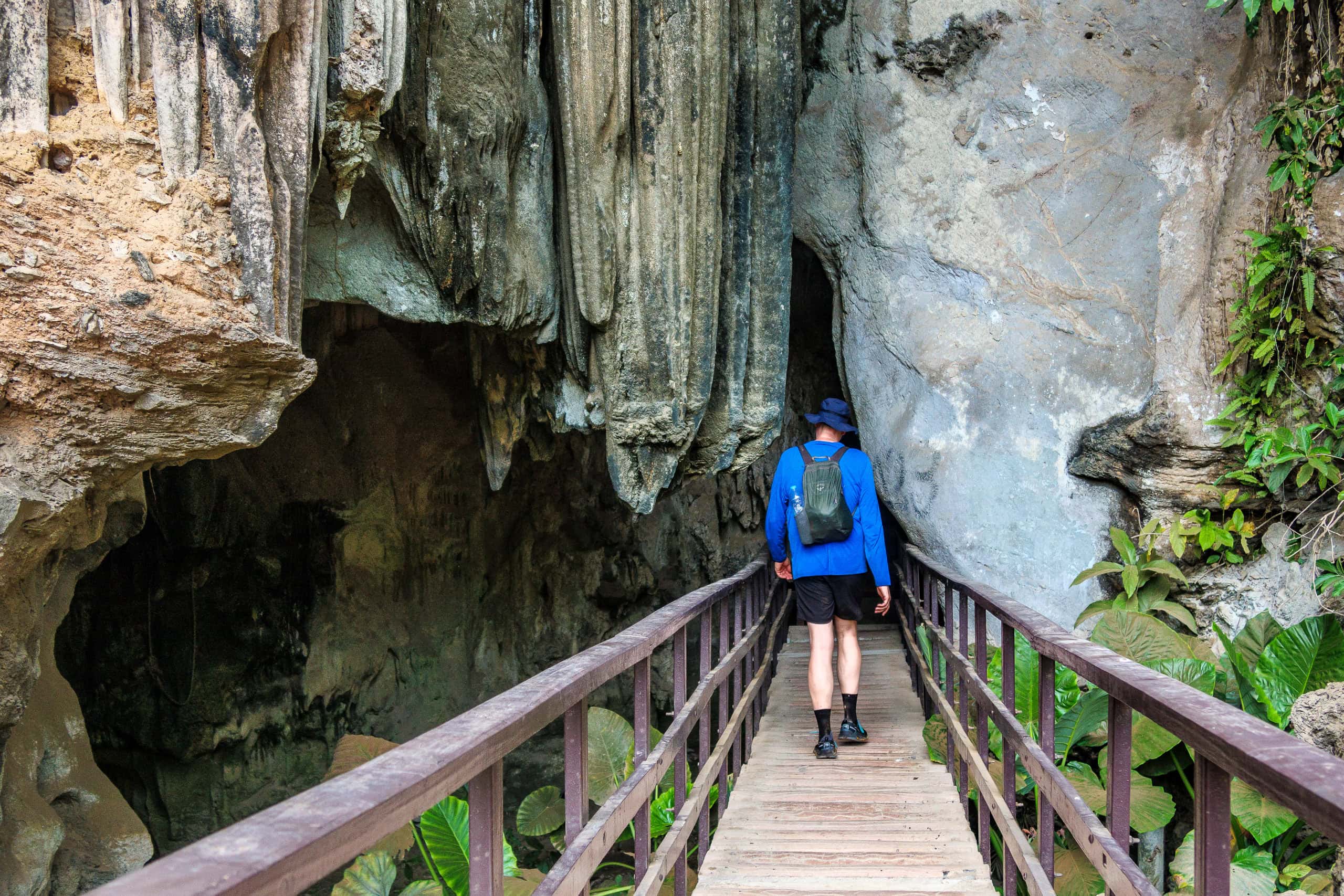
Although the size of the cave open to the public may be categorized as a smaller one of all show caves I have ever been to, taking just 10 to 15 minutes to walk around the entire route, it was definitely worth seeing. Right inside the cave mouth was a short, narrow corridor going through a big crevice that already had some eye-catching cave formations.

At the end of the crevice corridor, we entered the grand hall, where all the walls were decorated with the intricate crafts of Earth’s wonder. It looked as if thousands of jellyfish were floating around us or we were standing in the middle of waterfalls and cascades.
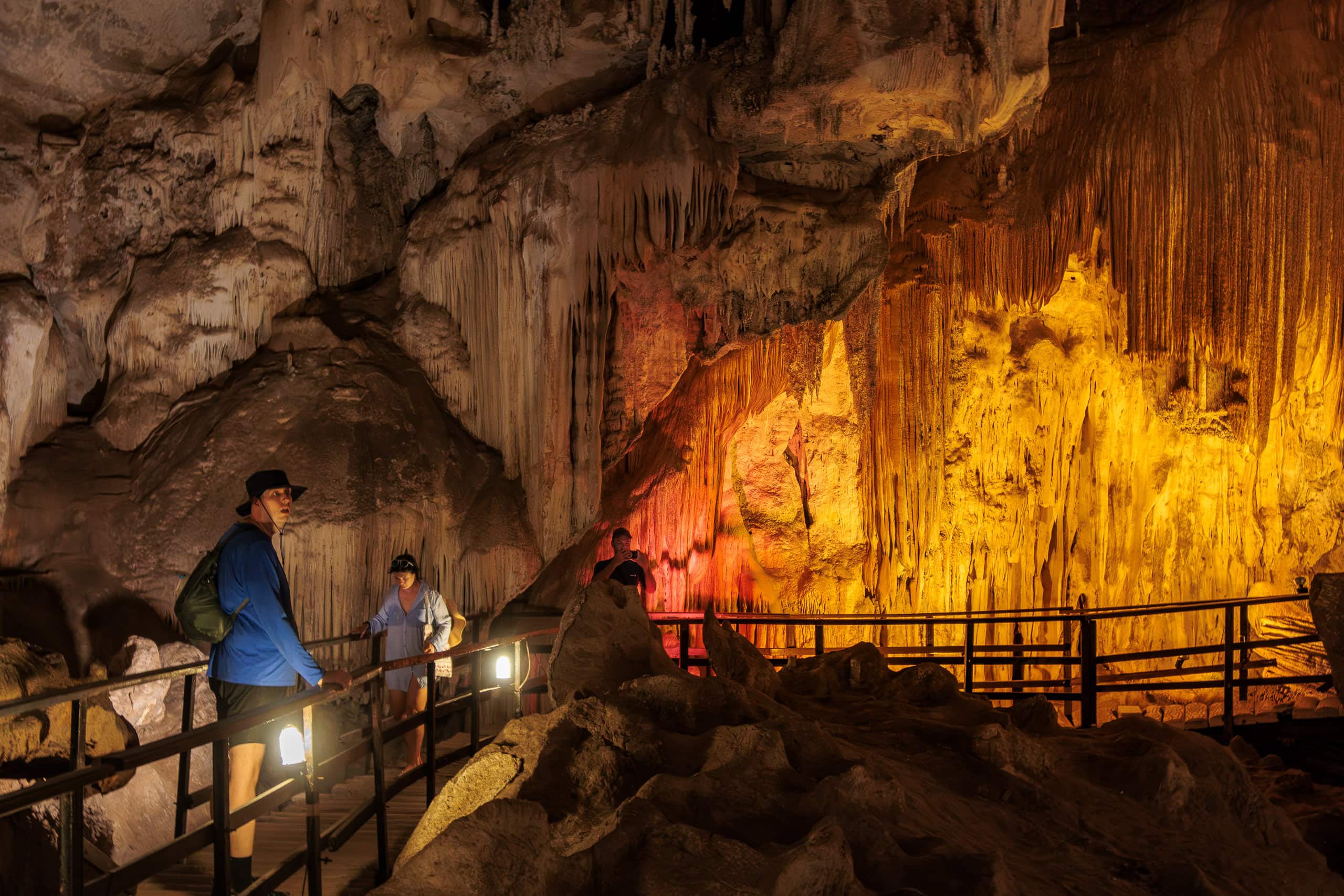
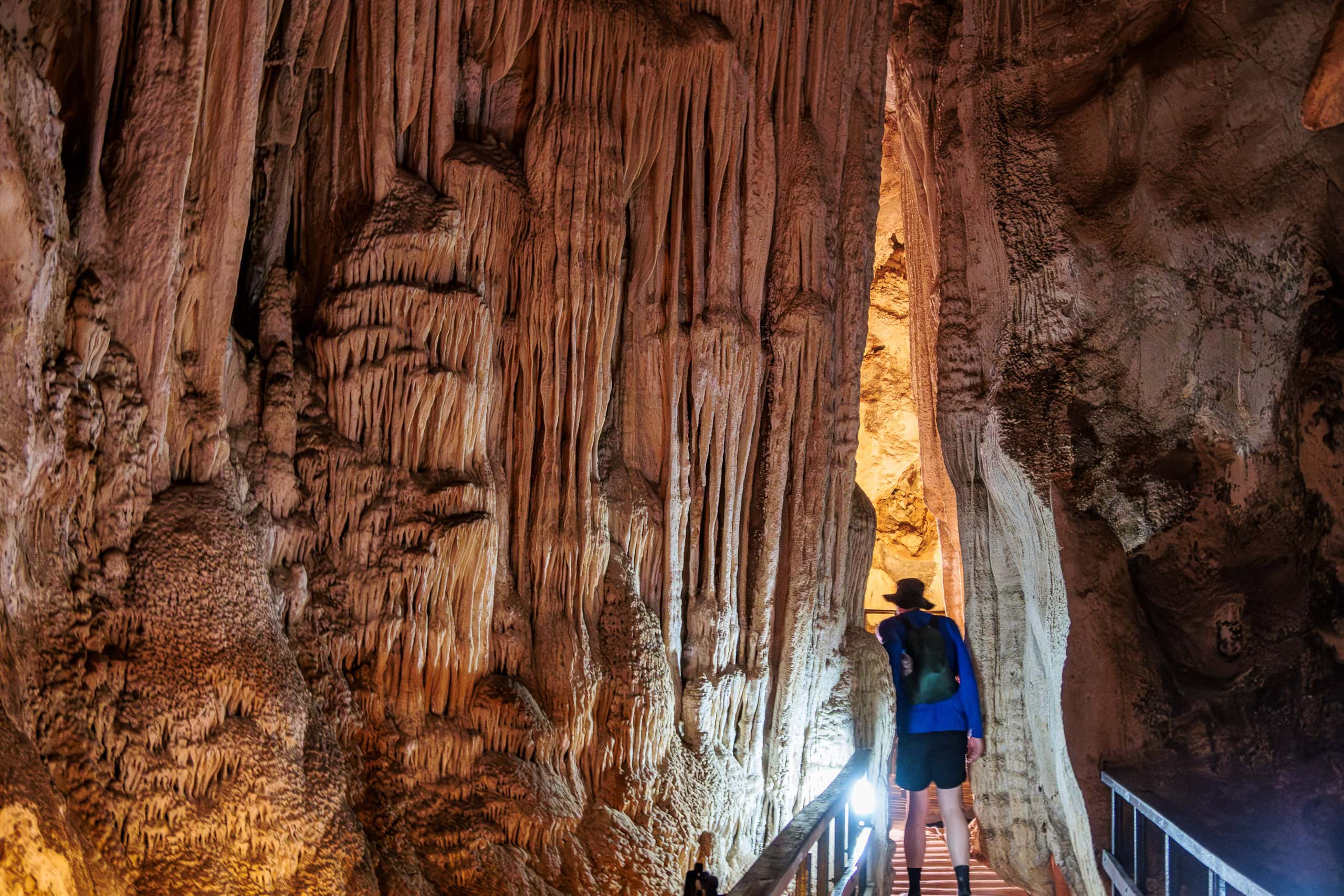
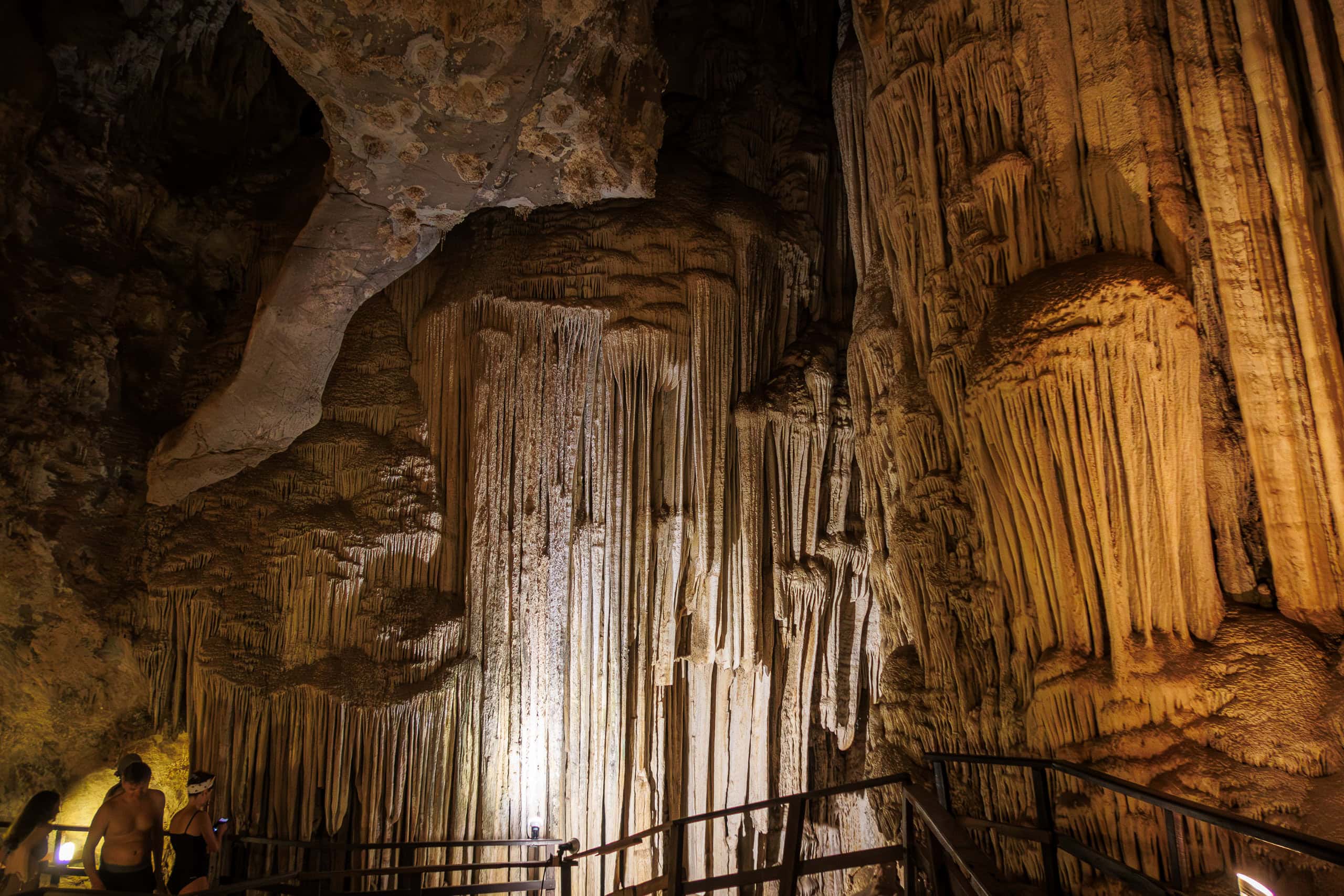
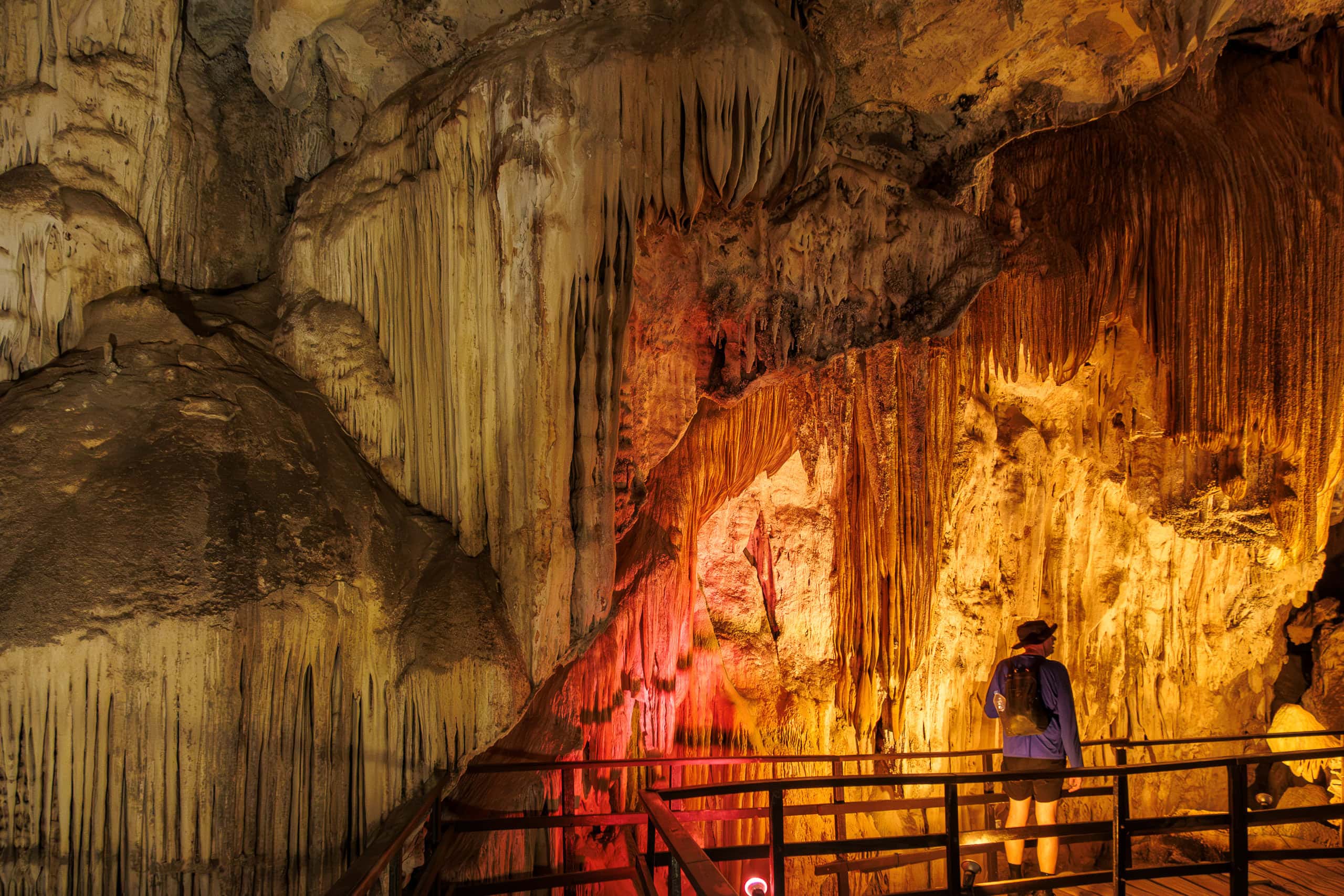

It was much more impressive than we expected, and we really enjoyed being there. The cave was only a short walk away from the Railay’s main street, so we saw a few other vacationers in the grand hall, too. All looked like they were having a good time.


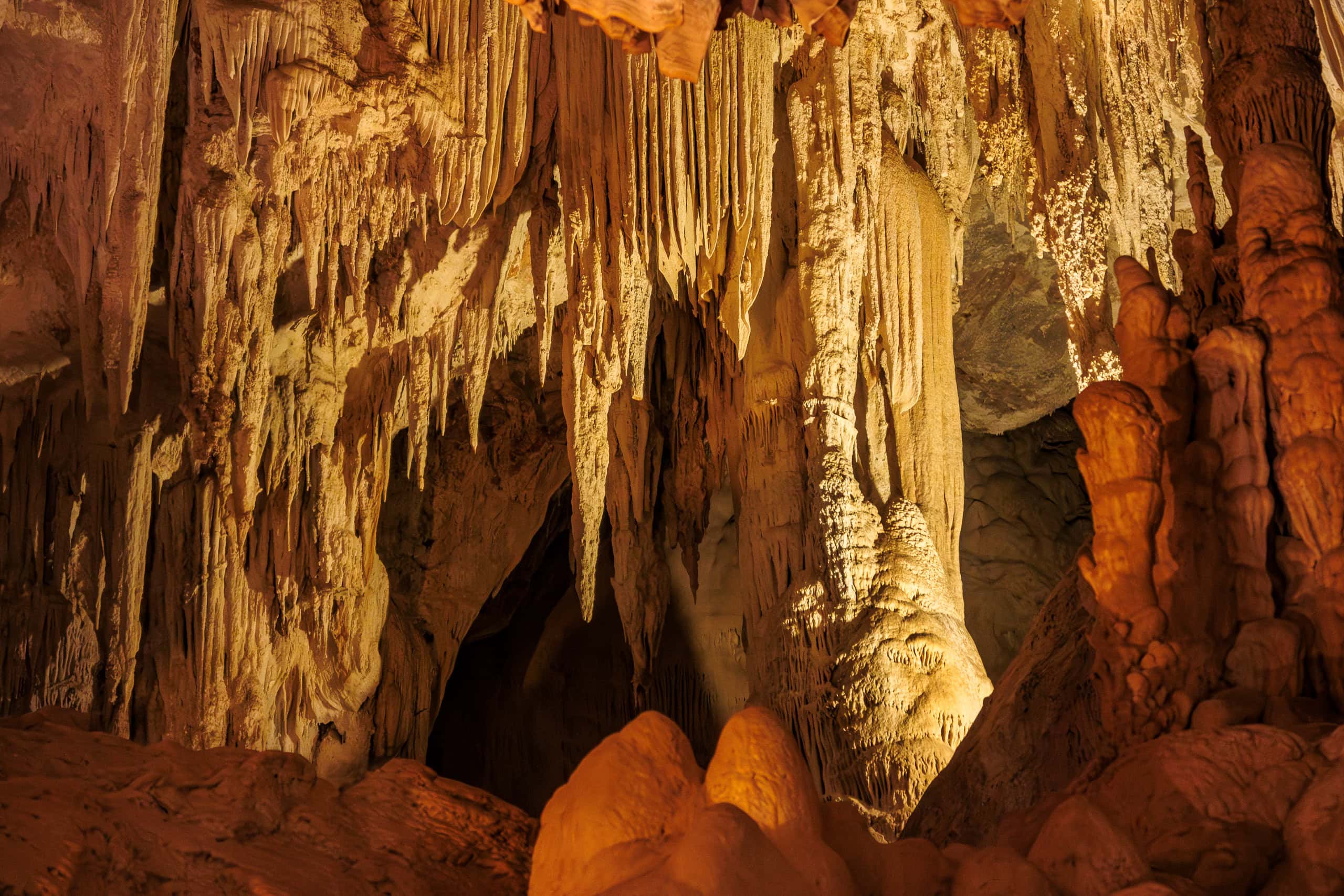

We walked back to the Railay West Beach through the more lively and busier main street. With another boat ticket we had kept in our hand, we entered the sand beach. Before long, a Thai staff came, picked up our tickets, and pointed one of the long-tail boats at the shore.
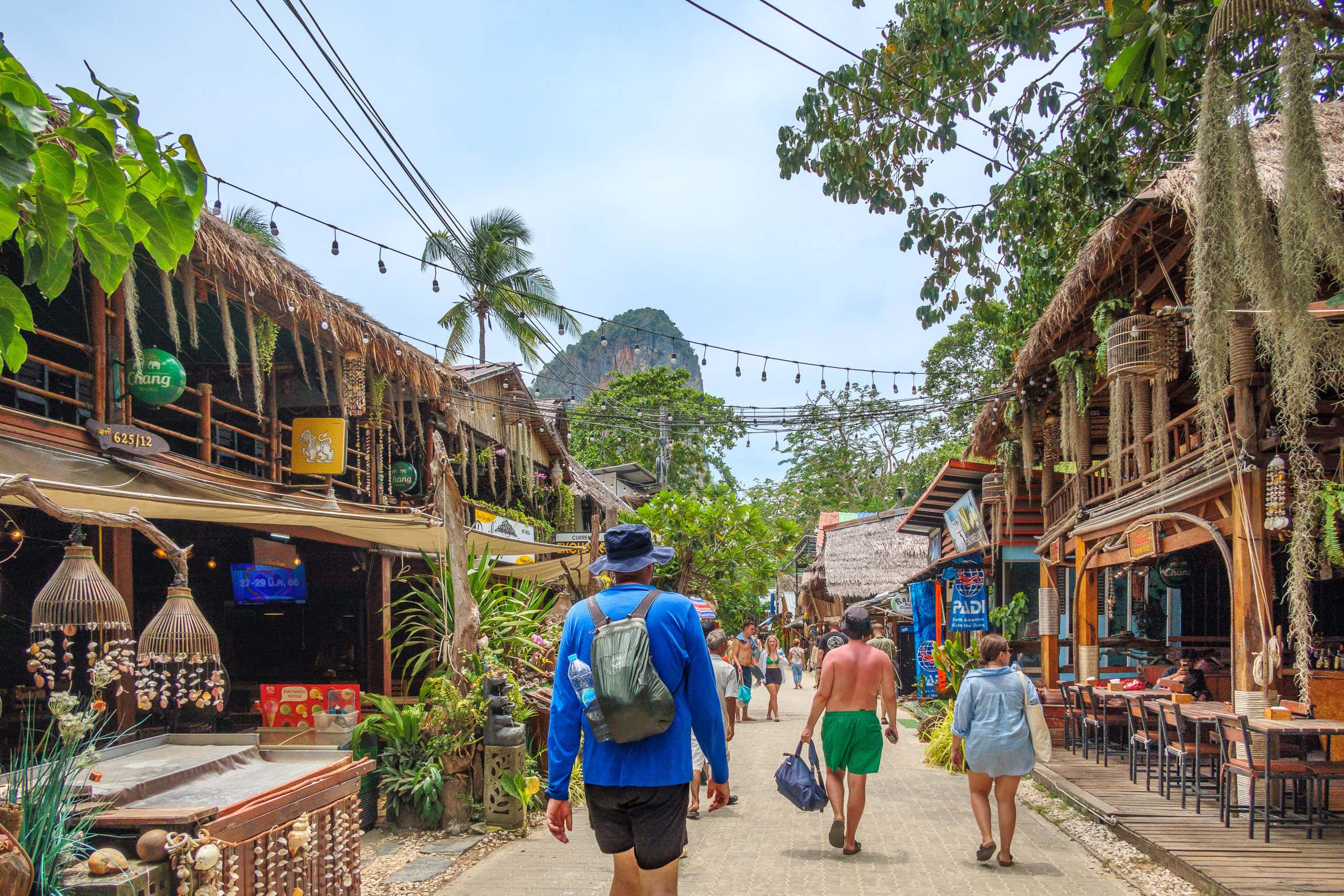


As our boat was speeding up and moving away from the Railay West Beach, more long-tail boats from Ao-Nang Beach passed us. It was merely 1 p.m., so there was still plenty of time for the people to enjoy the beautiful Railay Beaches.


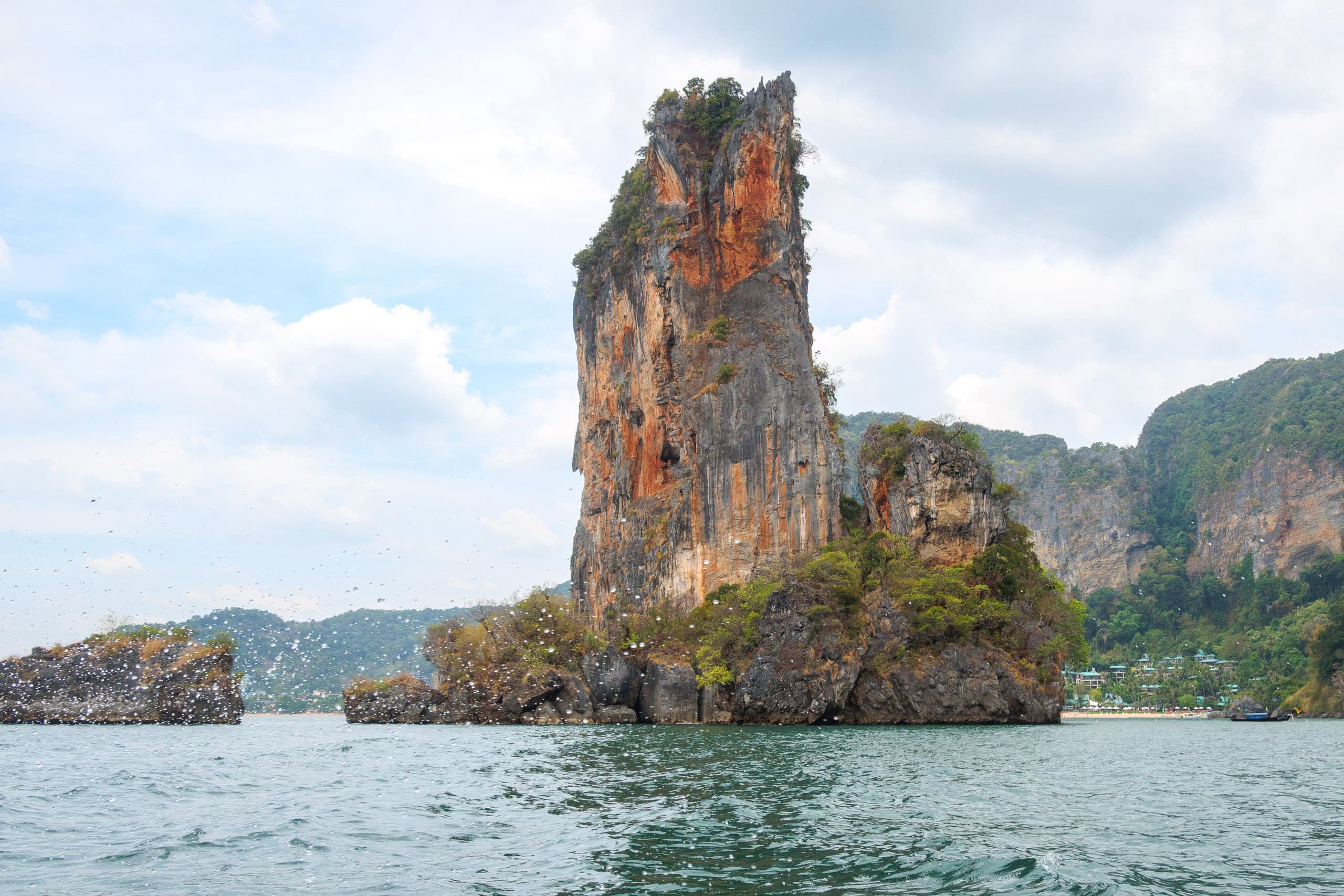
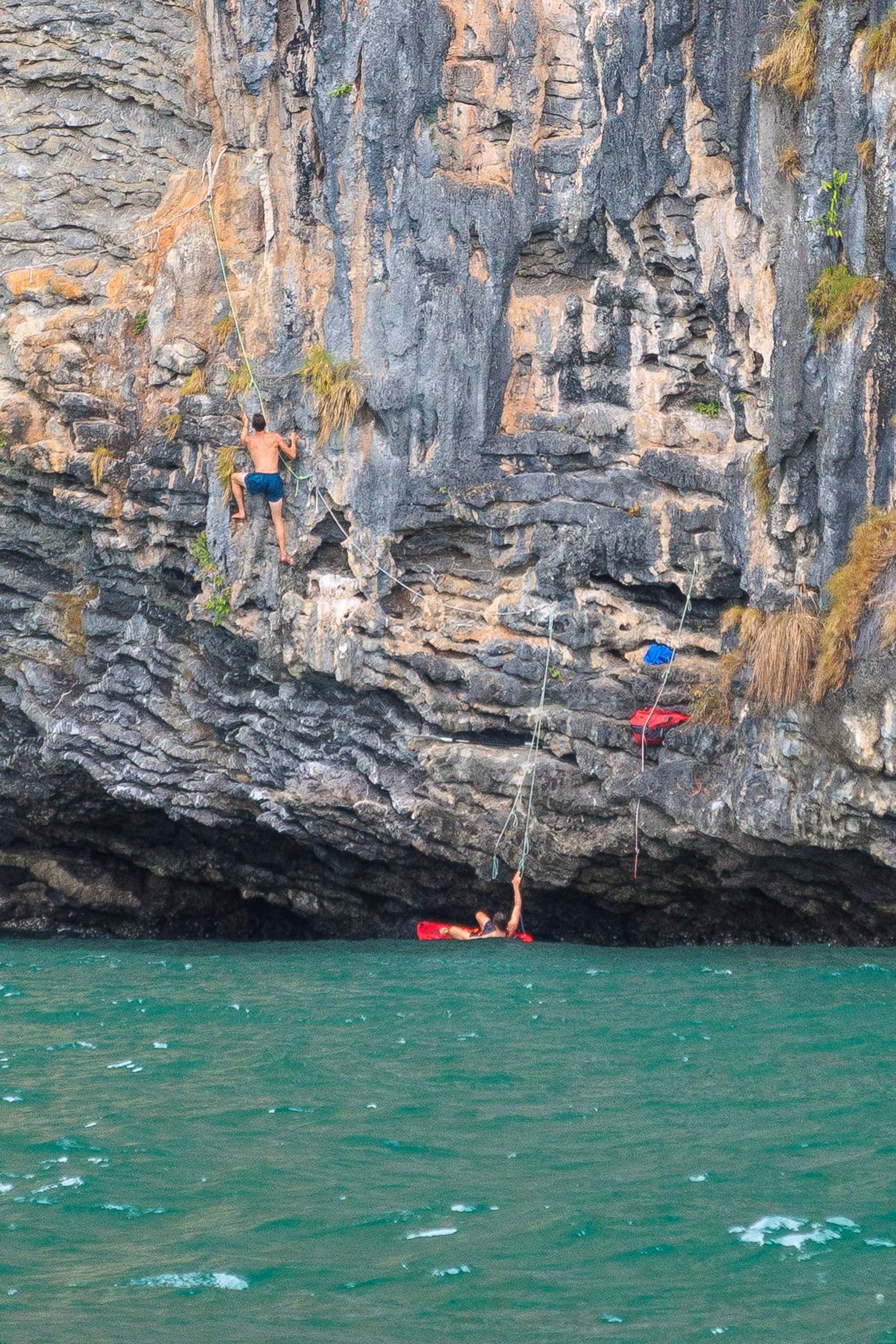

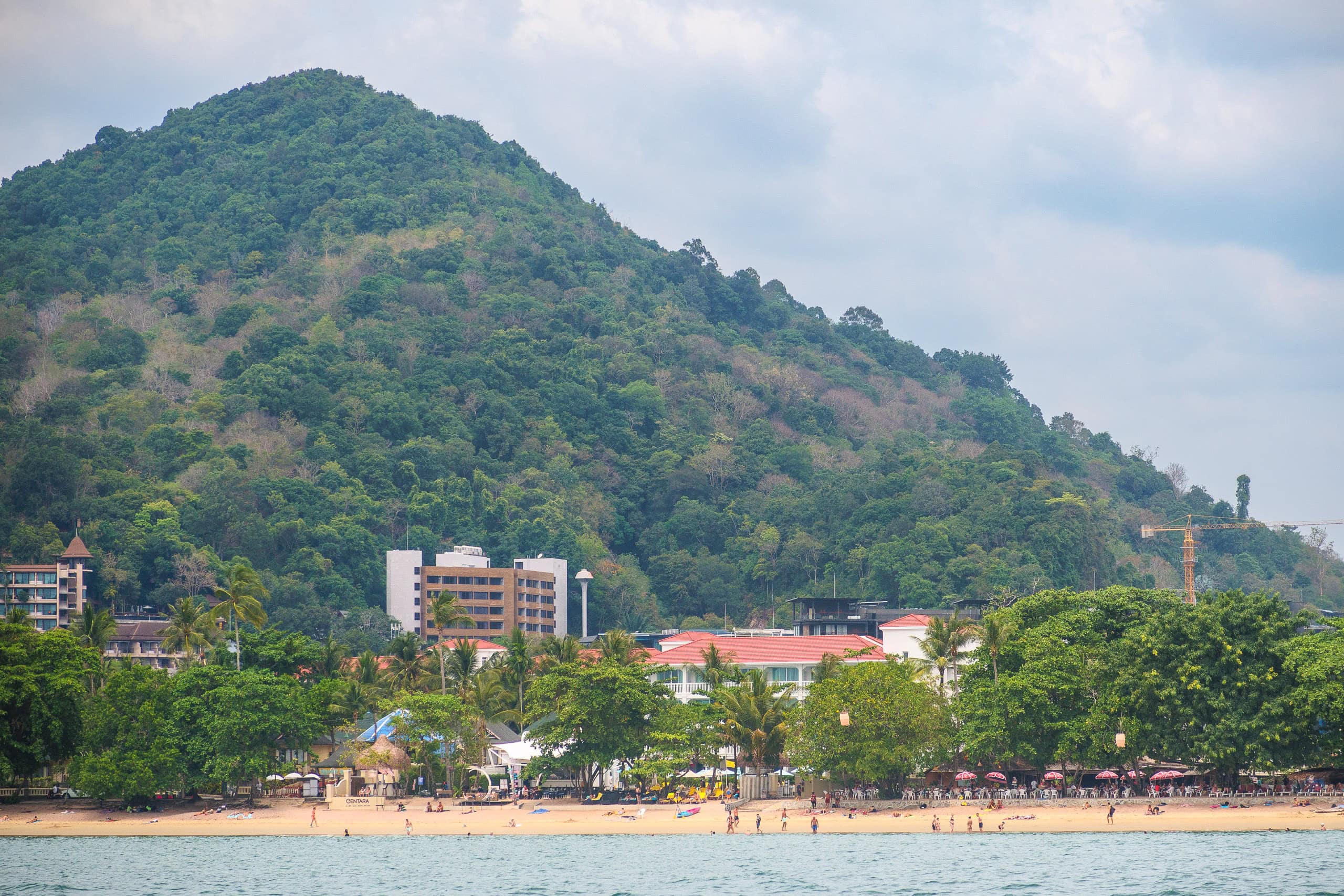
We didn’t reach the deepest part of the Bat Cave, and that alone gives us a reason to return — Railay still holds a few mysteries waiting in its cliffs. For such a small peninsula, this place feels like a concentrated version of everything a tropical beach resort can offer: white sand, turquoise water, quiet coves, and adventures hidden in stone. The Diamond Cave, unexpectedly beautiful with its glowing formations, was a perfect finale to our day.
As our boat glided over the sea, leaving behind the happy cheers and voices of Railay East Beach, the countdown to our next visit to Ao-Nang and Railay had already begun…



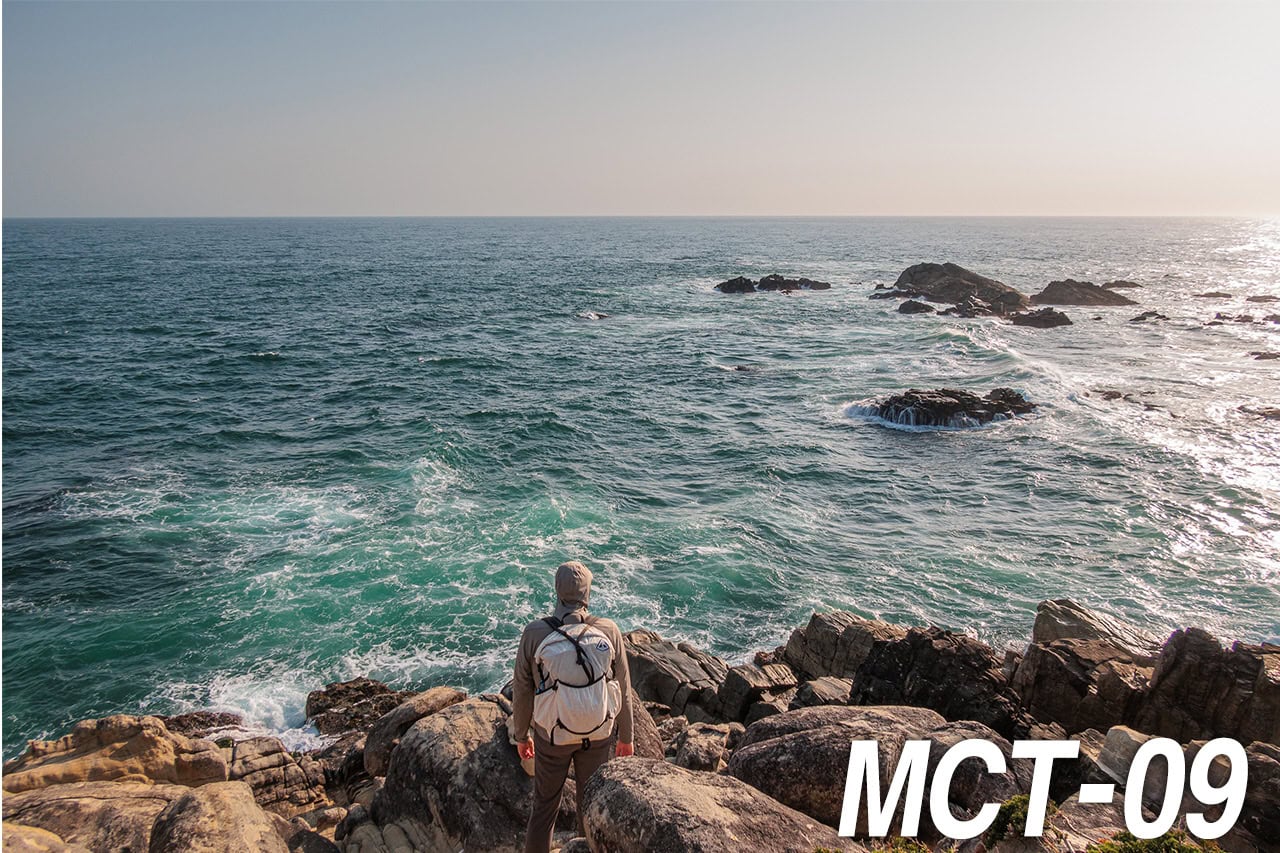

Comments